INTRODUCTION
July 2018 marks the 10th anniversary of Christopher Nolan’s Oscar-winning superhero film The Dark Knight (2008). We’ve already looked at the comic book influences on the other two entries in Nolan's Batman trilogy. Now it’s time we analysed the most popular instalment of all. Luckily for us, the filmmakers have been forthright in acknowledging the influence of the comics on the development of the movie. With previous analyses, we drew many comparisons based purely on speculation. But in the case of Nolan’s 2008 movie, many of the major influences have been explicitly confirmed by the cast and crew.
Director Christopher Nolan spoke to Variety about the influence of Batman: The Killing Joke (1988) by Alan Moore and Brian Bolland:
“As far as the specific influence of The Killing Joke, really we looked at the whole history of the comics and tried to absorb the highlights and commonalities from the evolutionary pool of artists and writers who've worked on the character for so long, looking at the common threads there. But I definitely feel the influence of The Killing Joke, not so much in the specifics as in constructing some sense of purpose for an inherently purposeless character. That is to say The Joker is an anarchist. He's dedicated to chaos. He should really have no purpose but I think the underlying belief that Alan Moore got across very clearly is that on some level The Joker wants to pull everybody down to his level and show that he's not an unusual monster and that everyone else can be debased and corrupted like he is.”
Nolan also credited the earliest Golden Age Joker stories as an influence:
“If you look at the first two appearances of The Joker ever in the Batman comics, we were quite startled to look back at those and realize how close that character is to what Heath's done and what our story is. I think it's very close to the original incarnation of the character some 65 years ago.”
Joker co-creator Jerry Robinson served as a consultant on the film, and screenwriter David S. Goyer also met with artist Neal Adams to discuss the project. According to Adams, Goyer cited ‘The Joker’s Five-Way Revenge!’ (Batman Vol 1 #251, September 1973) as an influence on the movie.
As with Batman Begins (2005), Nolan has named Jeph Loeb and Tim Sale’s Batman: The Long Halloween (1996-1997) as a major influence. Speaking to MTV, Nolan commented:
"I'd really say [our films] are a very large survey of the comic history. The Long Halloween has a great, triangular relationship between Harvey Dent and Gordon and Batman, and that's something we very much drew from."
Another apparent influence on the film is Batman: Dark Detective II (2005) by Steve Englehart and Marshall Rogers. Englehart himself has expressed frustration over the fact the filmmakers did not credit him for what he perceives to be an adaptation of his work.
"I figure 70 per cent of Batman [the 1989 film] was based on my stories and treatments. I'd peg The Dark Knight about the same, since all the main concepts are mine, though the usage of them was more free-form."
Nolan’s depiction of the Joker draws heavily from the works of writer Grant Morrison. Two of Morrison’s stories which were especially influential on the film were Arkham Asylum: A Serious House on Serious Earth (1989) and ‘The Clown at Midnight’ (Batman Vol 1 #663, April 2007). Heath Ledger kept a Joker diary during the making of the film which included notes and art work taken from these stories. Morrison commented on this in an interview with MTV:
“He actually had a whole list — blind babies, doctors, accidents — really horrible stuff. Heath wrote it all down. So yeah, I can see there’s a lot of [Arkham and ‘Midnight’] in his Joker.”
Several extracts from ‘The Clown at Midnight’ can be found in Ledger’s Joker diary. The actor also confirmed he read The Killing Joke and Arkham Asylum: A Serious House on Serious Earth. Ledger commented on the importance of the comics in helping him establish his characterisation of the Joker during a 2007 interview with Empire:
"It’s a combination of reading all the comic books I could that were relevant to the script and then just closing my eyes and meditating on it. I sat around in a hotel room in London for about a month, locked myself away, formed a little diary and experimented with voices — it was important to try to find a somewhat iconic voice and laugh. I ended up landing more in the realm of a psychopath — someone with very little to no conscience towards his acts."
Reading these quotes, it becomes clear that the cast and crew did extensive research into the source material. But how close is the finished film to the comics that inspired it? Let’s go through the movie scene by scene and find out. Some of the parallels noted here will be deliberate, while others will likely just be coincidental. At any rate, we’re going to note as many parallels between the film and the comics as possible to see just how accurately one reflects the other.
The film begins with a bank robbery orchestrated by the Joker. Throughout this scene the Joker’s henchmen sport clown masks resembling the makeup worn by the Joker’s goons in the opening scene of ‘The Clown at Midnight’. Both opening sequences conclude with the henchmen being murdered by the Joker.
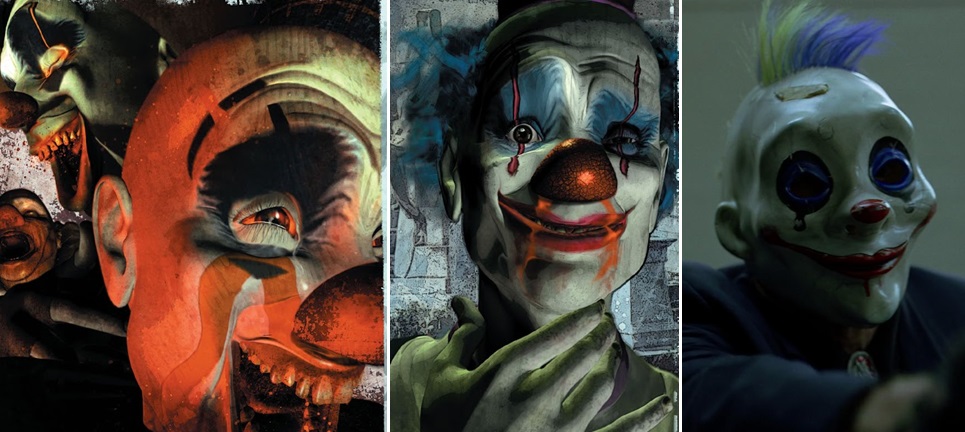
The Joker has dressed his henchmen up as clowns in many other comics over the years. The following example is from Batman: The Man Who Laughs (2005) by Ed Brubaker and Doug Mahnke.
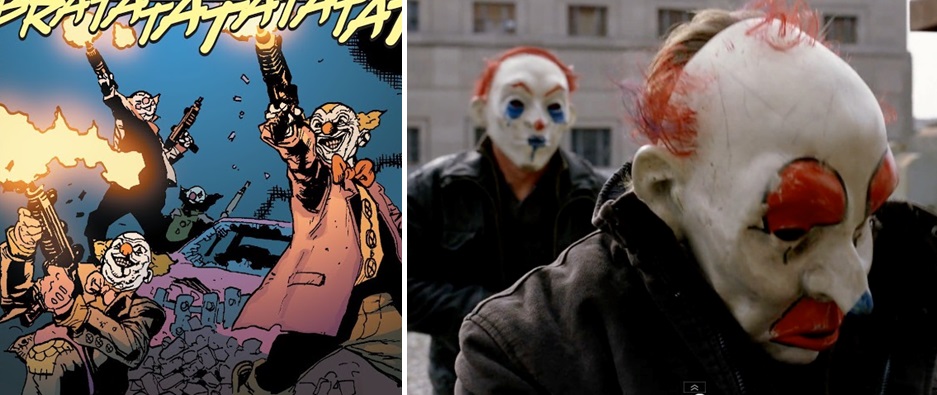
He's also been shown to spontaneously kill his own goons in numerous comics; a tradition that dates back as far as ‘The Joker’s Five-Way Revenge!’ He tricks them into killing each other in the film and then murders the last one himself. This recalls a line from ‘The Clown at Midnight’ regarding his treatment of his underlings:
![]()
The Joker’s own mask during the opening heist may have been inspired by the Pagliacci mask worn by the Cesar Romero Joker during his debut episode on the 1966-1968 Batman TV show: ‘The Joker is Wild’ (season 1 episode 5).
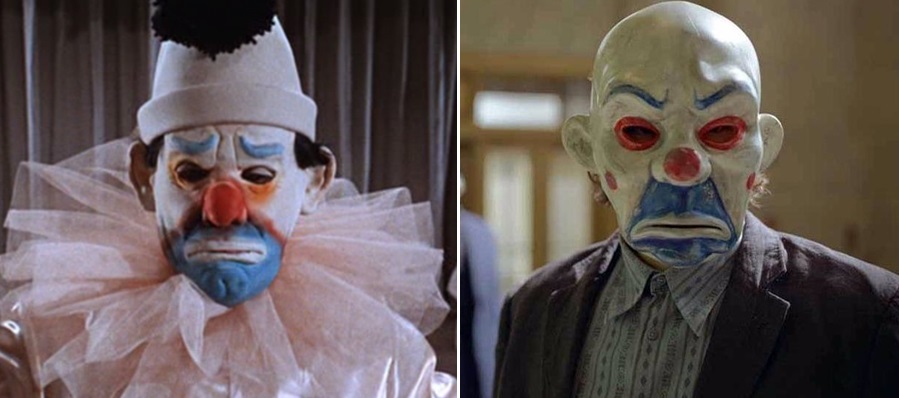
The Joker removes his mask to reveal his true identity to the wounded bank manager. The following comparison is from the ‘The Case of the Lucky Law-Breakers’ (Batman Vol 1 #9, February 1942).

The Joker’s distinctive appearance in this film draws inspiration from a number of sources. While the comic book Joker is traditionally depicted with a fixed smile on his face, the movie incarnation instead has a Chelsea grin carved into his flesh. Ledger’s Joker was not the first version of the character to display such scars. One example can be found in the Elseworlds book Batman: Gotham Noir (2001), by Ed Brubaker and Sean Phillips, in which Jack Napier sports a Chelsea grin.

Ledger’s Joker also bears a striking resemblance to artist Lee Bermejo’s depiction, as featured in his and Brian Azzarello’s 2008 graphic novel Joker. This book went on sale three months after The Dark Knight’s theatrical release, but Bermejo had been working on it for some time beforehand and an early preview of his Joker design had been posted on Batman-On-Film back in December 2005.
Bermejo’s Joker had also previously appeared on the front page of a newspaper featured in Lex Luthor: Man of Steel Vol 1 #3 (July 2005). So it’s feasible his interpretation may have informed the look of Ledger’s Joker.
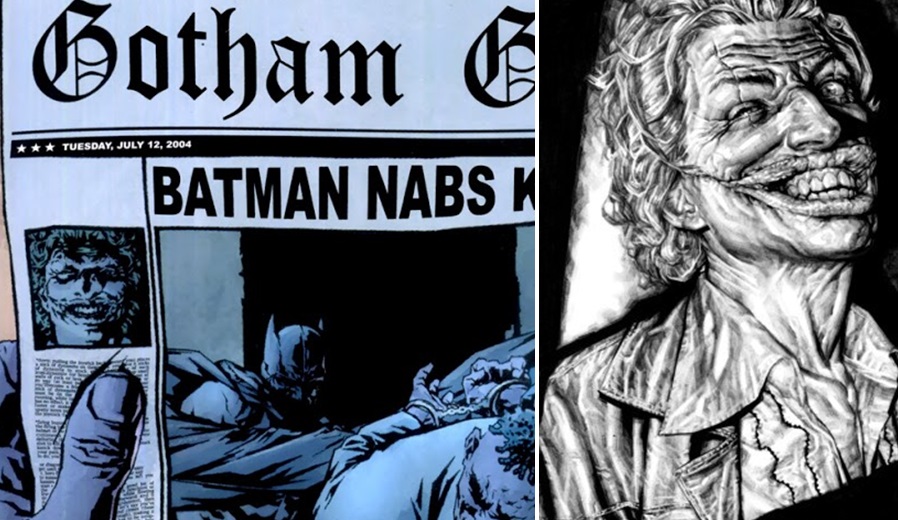
The mainstream New Earth Joker also sported a Chelsea grin at the time The Dark Knight was in production. He acquired this after being shot in the face by Josef Muller in ‘Batman and Son Part I: Building a Better Batmobile’ (Batman Vol 1 #655, September 2006). The Joker’s post-surgical appearance, with prominent scars running up his cheeks, was revealed in ‘The Clown at Midnight’.
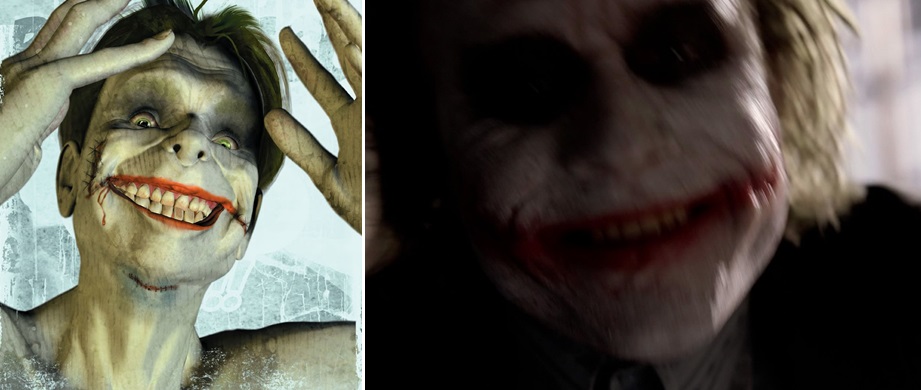
The skin of the Ledger Joker is not bleached. Instead he wears makeup. The character’s white face was a mystery when he first appeared in ‘The Joker’ (Batman Vol 1 #1, June 1940). The explanation that his skin had been bleached by chemicals was not established until 1951. For most of the Golden Age, his peculiar complexion was never explained.
The Joker wears lipstick in the movie. He also wears lipstick in Batman: The Dark Knight Returns (1986) by Frank Miller and Klaus Janson.
The suit he wears throughout most of the film is a faithful recreation of his classic purple and green comic book costume. Ledger also presents a strong match for the physical characteristics of the comic book Joker, standing at over six feet in height and sporting a slim, wiry build. His dishevelled hair, dark eyes and distinctive posture are all indebted to Dave McKean’s portrayal of the character in Arkham Asylum: A Serious House on Serious Earth.
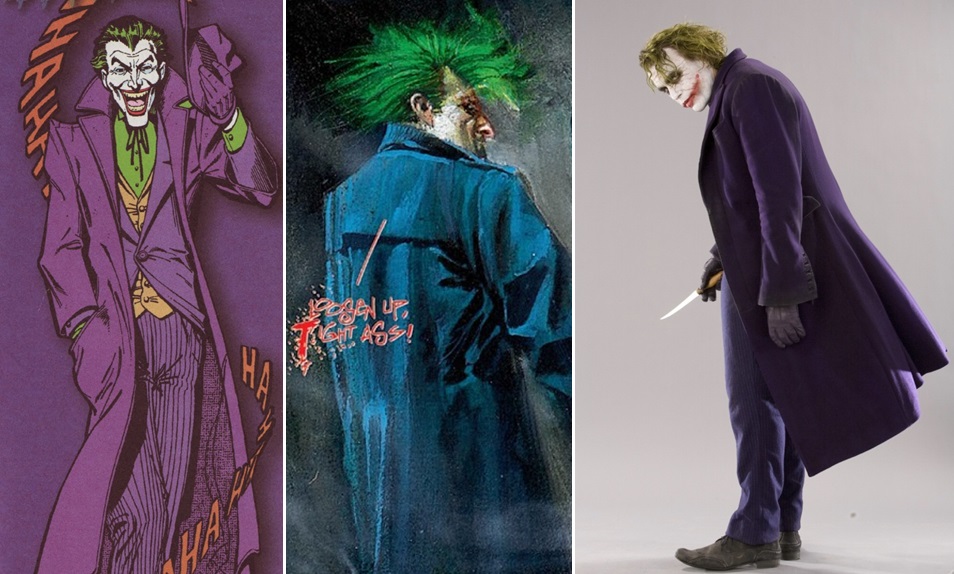
The Joker’s lip smacking in the film could have been derived from the following description in ‘The Clown at Midnight’:
“Until there is only a single Joker voice smacking its lips in the huge echoing emptiness of a place, let’s call it his soul, of such utter dereliction there are no words broken enough to describe it.”
However, in the recent documentary "I am Heath Ledger", it was revealed that the prosthetic make-up that attached to his lips would often loosen and crack. So as a way to keep from spending more time in the make-up chair he would lick the appliance to keep it in place.
The opening heist scene concludes with the Joker placing a grenade in the bank manager’s mouth and calmly walking away. The bank manager braces himself for the blast, only to discover it is a smoke grenade. This subversion of his victim’s expectations is a good example of the Joker’s unpredictable sense of humour in the comics. The gag may have been inspired by a scene from ‘Judgements’ (Batman Vol 1 #451, July 1990).

The next major character we see in the film is Lieutenant James Gordon, played by Gary Oldman. The image of him standing beside the Bat-Signal atop the roof of police headquarters is one that's been used countless times in the comics.
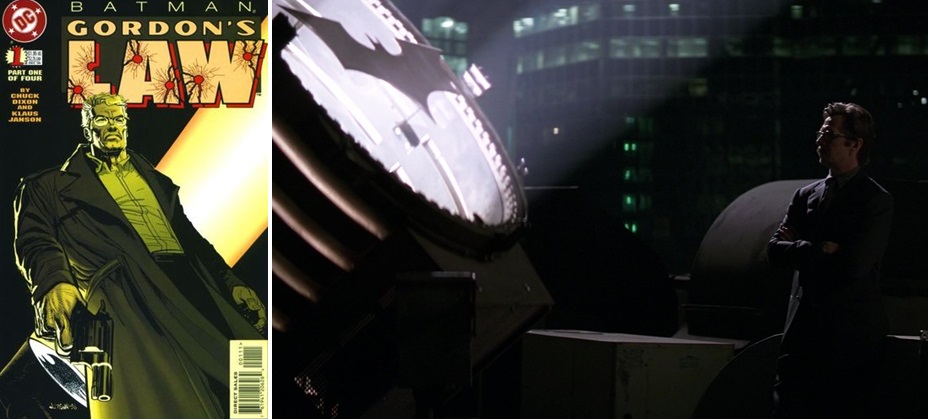
Gordon has two detectives under his command at the Major Crimes Unit named Anna Ramirez and Gerard Stephens, played by Monique Gabriela Curnen and Keith Szarabajka respectively. These can be seen as the Nolanverse answer to the comic book characters Renee Montoya and Harvey Bullock.
Elsewhere in Gotham a meeting is taking place between two groups of criminals in a multi-storey car park. Amongst the attendees is Scarecrow, played once again by Cillian Murphy.
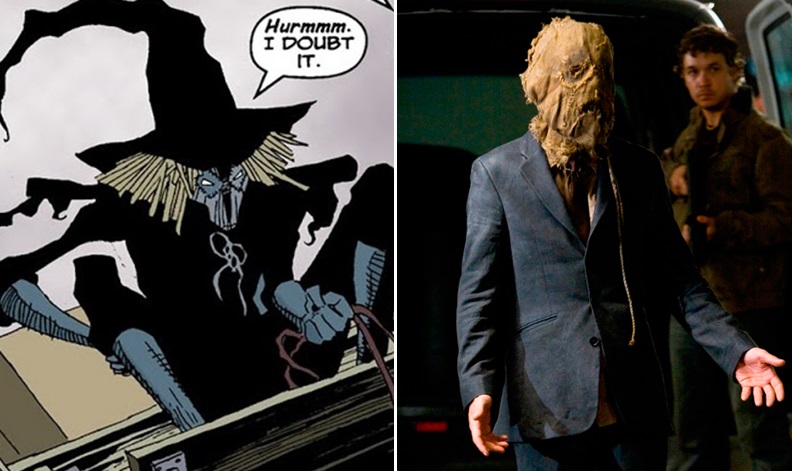
The meeting is interrupted by the arrival of a gang of copycat vigilantes dressed as Batman. There have been numerous Batman imitators in the comics, but the gang in the film was most likely inspired by the Sons of Batman from The Dark Knight Returns.
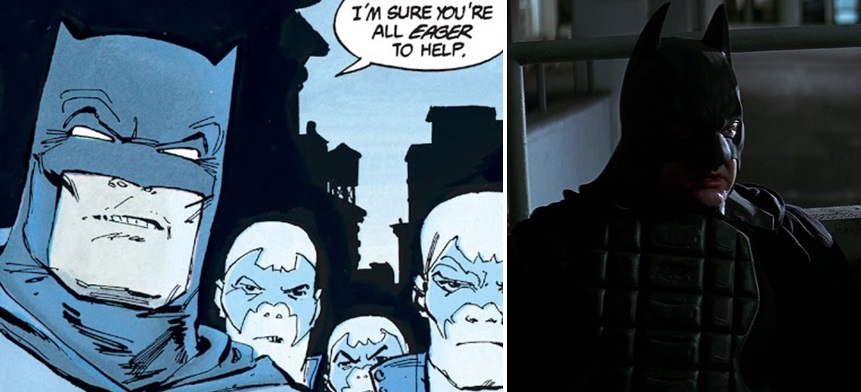
The Tumbler arrives on the scene, operating on autopilot, and creates a distraction to draw the fire of the mobsters. Batman has made similar diversionary use of the Batmobiles in the comics, as demonstrated in this scene from Batman: Bride of the Demon (1991) by Mike W. Barr and Tom Grindberg.

The Tumbler itself debuted in Batman Begins (2005) but had already been incorporated into the comics by time The Dark Knight was released. The following panel is from ‘Lovers & Madmen, Part I: It’s Funny’ (Batman Confidential Vol 1 #7, September 2007).

The action sequence where Christian Bale's Batman leaps onto a moving vehicle driven by Scarecrow may have been inspired by a scene from Batman: Dark Victory (1999-2000), the sequel to The Long Halloween.

After capturing Scarecrow, Batman visits the scene of the bank robbery where he and Gordon discuss their plan to trace the mob's money using irradiated bills. This might be a nod to the Batman and Robin (1949) film serial, in which Batman and Gordon use irradiated bills to trace ransom money.
Since Wayne Manor was burned down by the League of Shadows in the previous film, Bruce and Alfred are now living in a penthouse in the heart of the city. The comic book Bruce moved into a penthouse located within the Wayne Foundation after Dick Grayson left for college, as depicted in ‘One Bullet Too Many!’ (Batman Vol 1 #217, December 1969). He and Alfred continued to live there throughout much of the Bronze Age. Bruce partly did this in the comics so he could keep a closer eye on how his company was being run. Bruce also maintains a close watch on Wayne Enterprise’s business dealings in the film.
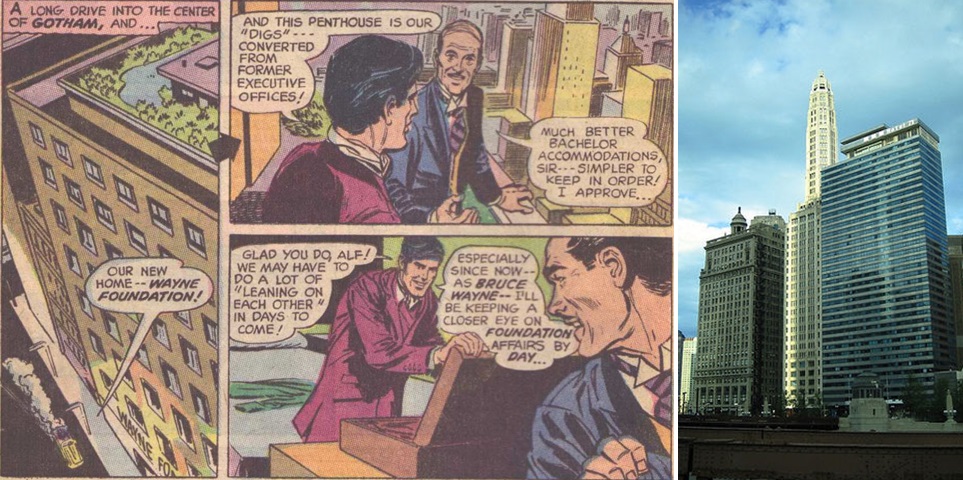
Batman now has a secondary Batcave situated beneath the city. He’s been shown to have a similar secondary HQ in the comics and made frequent use of it when living in his penthouse during the Bronze Age. The panels below are from ‘The Master Plan of Doctor Phosphorus!’ (Detective Comics Vol 1 #470, June 1977) by Steve Englehart and Walt Simonson.
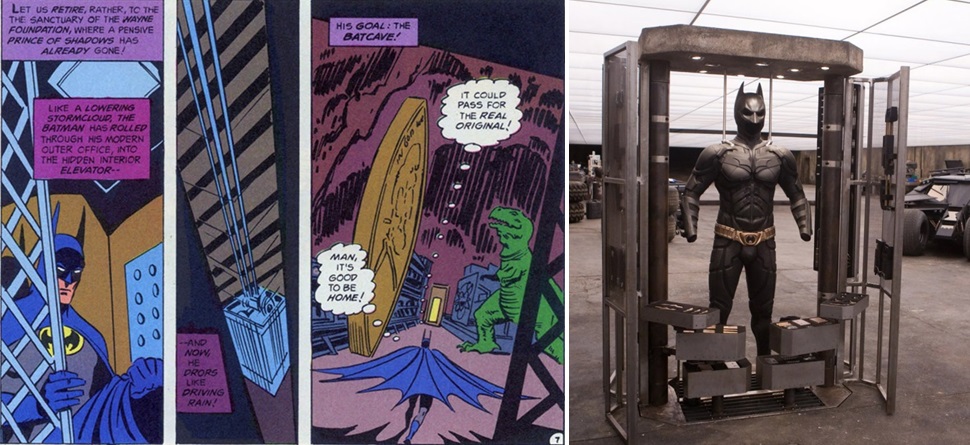
Michael Caine reprises his role as Alfred Pennyworth, Bruce’s loyal butler. Early in the film he is shown stitching up a wound on Bruce’s arm. In the comics Alfred is a trained field medic and often patches up Bruce’s injuries when his master is wounded in action. The movie also references Alfred’s background in the military; an aspect of the character’s history that was largely overlooked in the earlier films. The panel below is from Batman Versus Predator (1991).
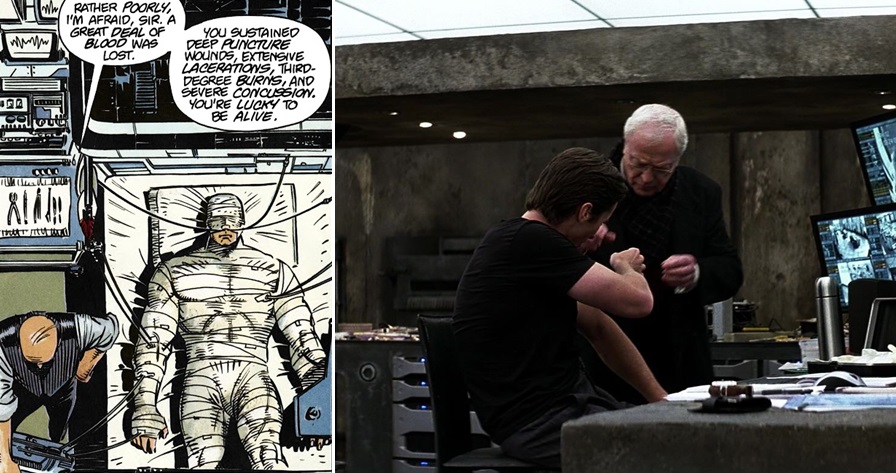
Bruce’s back is covered in scars in both the comics and the movie. The following panel is taken from Paul Dini and Alex Ross’ Batman: War on Crime (1999).
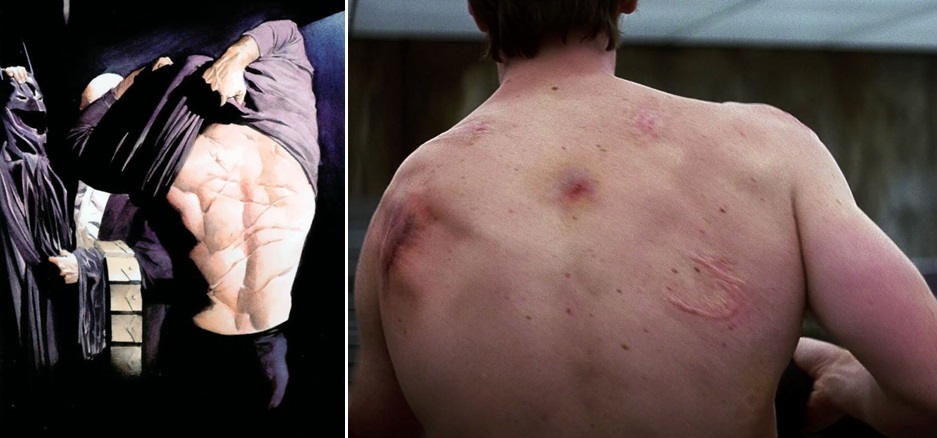
Aaron Eckhart portrays Harvey Dent in the movie. This character’s earliest comic book incarnation, named Harvey Kent, debuted in ‘The Crimes of Two-Face’ (Detective Comics Vol 1 #66, August 1942). At 6'0, Eckhart is the exact same height as the character in the comics. The film portrays him as a charismatic crusader with a violent temper, much like his counterpart on the printed page. In the source material he had a wife named Gilda, while in the film he is in a relationship with Rachel Dawes (played this time by Maggie Gyllenhaal).
The depiction of Harvey Dent in this film also draws influence from the character of Evan Gregory in Dark Detective II. Both men are fearless, idealistic crusaders running for public office. In the comic Evan is standing for state governor, while in the movie Harvey is campaigning for re-election as district attorney. There is a strong physical resemblance between actor Aaron Eckhart and Marshall Rogers’ depiction of Evan in the comics.
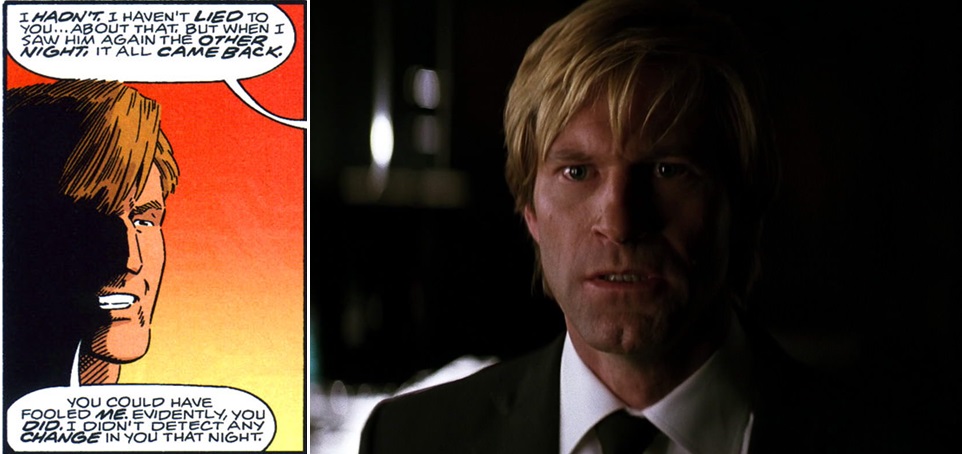
Evan Gregory and Harvey Dent are both in romantic relationships with a former love interest of Bruce Wayne: Silver St. Cloud in the comic, Rachel in the movie. Both women know about Bruce’s double life as a crime fighter but keep this secret from their current boyfriend. In both the comic and the movie, Bruce respects Evan/Harvey and helps fund his campaign, but is also secretly jealous of his relationship with Silver/Rachel.
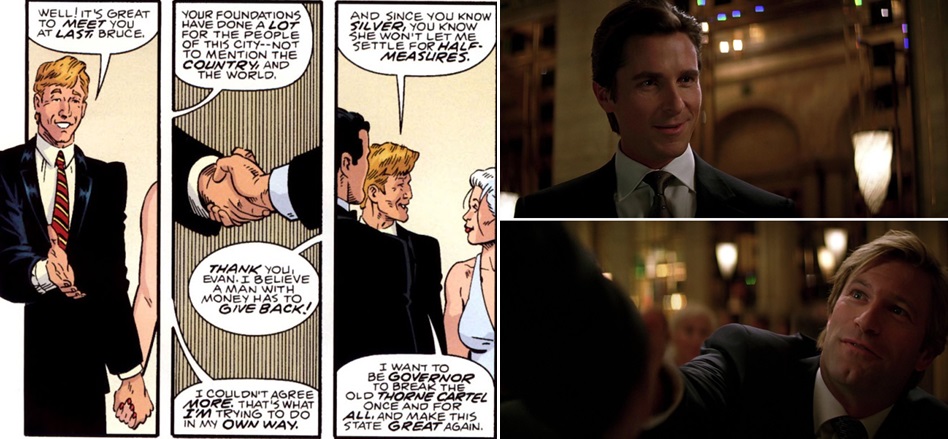
Although Evan and Harvey are two separate characters in the comic, their story arcs do overlap during the course of Dark Detective II. Two-Face becomes angered by the Joker’s attempts to interfere in Evan’s political campaign and threatens him against doing so. Evan and Harvey both end up falling victim to the Joker’s traps in the comic, as does Eckhart’s Dent in the movie.
In the film Harvey has a lucky coin which he flips to help him make decisions. He tells Rachel that the coin previously belonged to his father. He also acquired the coin from his father in the comic stories ‘The Eye of the Beholder’ (Batman Annual Vol 1 #14, March 1990) and The Long Halloween, while earlier comics had portrayed it as a piece of evidence from his case against Maroni.
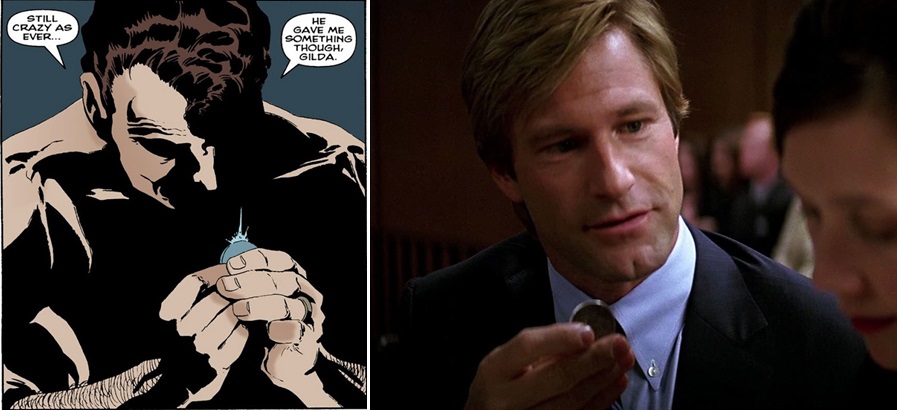
Sal Maroni appears in the film played by Eric Roberts. This character also debuted back in ‘The Crimes of Two-Face’.

The scene where the criminal on the witness stand draws a gun on Harvey is a reference to how Dent was scarred in the comics. In the source material, Maroni hurled acid in his face while Harvey was questioning him in court. The inclusion of this scene in the film is a red herring to subvert the expectations of comic fans.

Another comic book character to return from the previous film is Lucius Fox, played once again by Morgan Freeman. He is effectively running Wayne Enterprises in Bruce’s stead, much like he does in the comics.
Bruce’s reluctance to deal with Lau echoes his aversion to dealing with the Falcone family in The Long Halloween, or with Randall Winters in War on Crime, or with Henry Claridge in The Man Who Laughs. In all of these stories Bruce knows his business acquaintance has a secret history of illegal activity and thus refuses to deal with them.
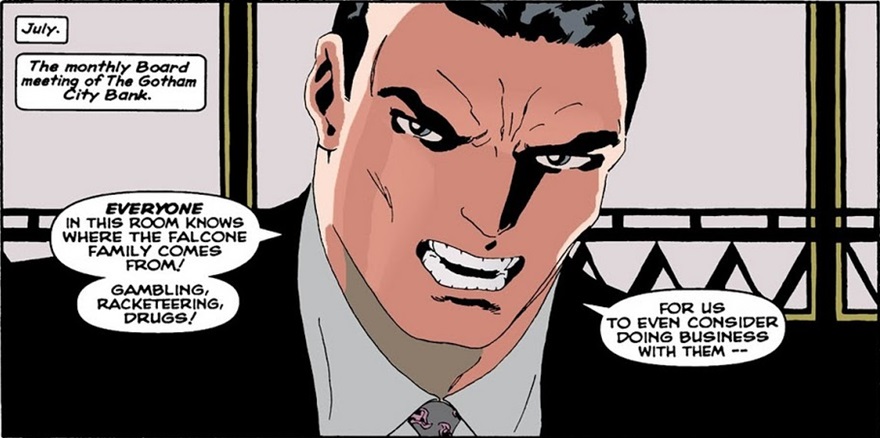
The next time we see the Joker is during a conference of mob bosses. During this scene the Joker kills the henchman of a mobster named Gambol by stabbing him through the eye with a pencil. The humorous way he executes this murder is typical of his theatricality in the comics. The murder itself recalls a scene from Arkham Asylum: A Serious House on Serious Earth where the Joker stabs Pearl through the eye with a freshly sharpened pencil while talking to Batman on the telephone.
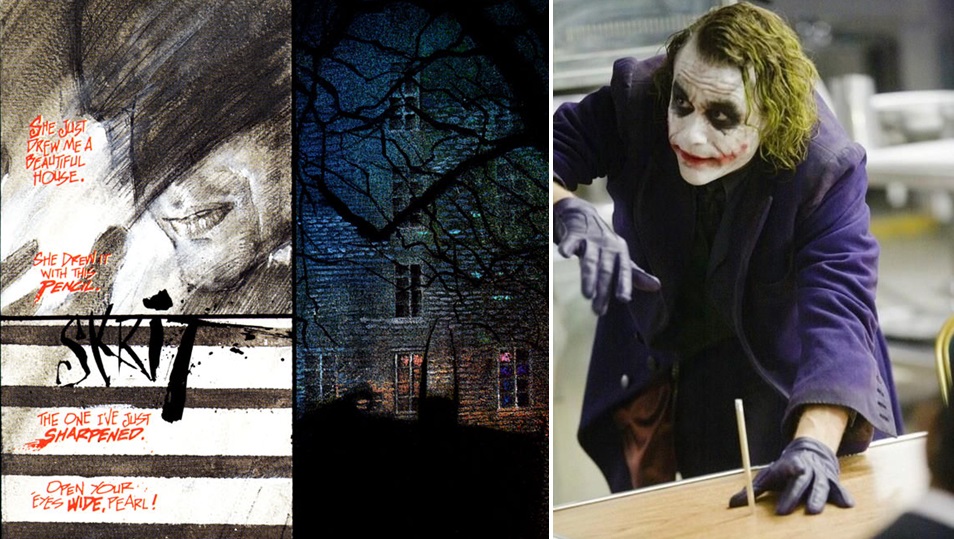
Later in the story Batman discovers Pearl is in fact alive and well, and her death turns out to be an ‘April Fool’ prank. This marks yet another example of one of the Joker’s fake-out killings, similar to the smoke grenade he puts in the bank manager’s mouth at the start of the film.
The image of the Joker wired up with explosives might have been inspired by a scene from Batman: The Cult (1988) by Jim Starlin and Bernie Wrightson. This particular story is thought to have been a major influence on Nolan’s third Batman movie, The Dark Knight Rises (2012), so there's a good chance the visual similarity in The Dark Knight is intentional.
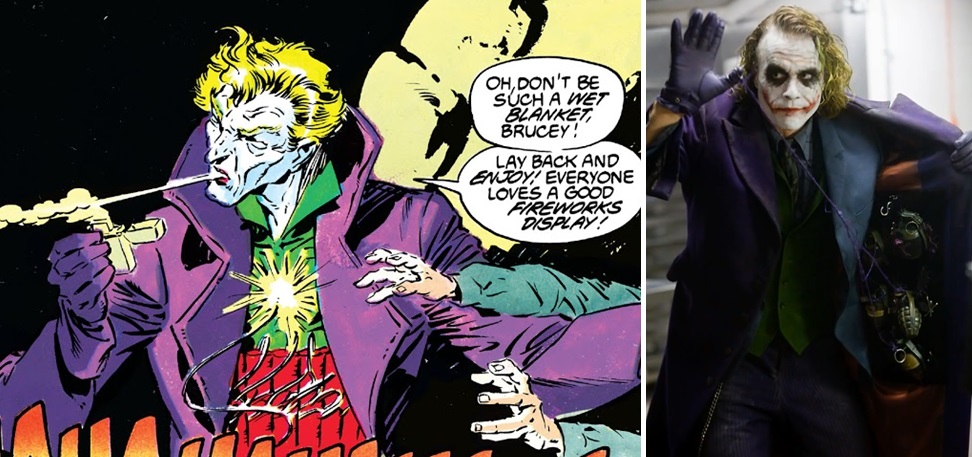
The scene where Dent, Gordon and Batman meet beside the Bat-Signal on the roof of police headquarters is taken from The Long Halloween. In both stories, the trio conspire to take down the gangsters that are corrupting Gotham.

The scene in both the comic and the movie concludes with Batman disappearing and Gordon telling Harvey “He does that.”
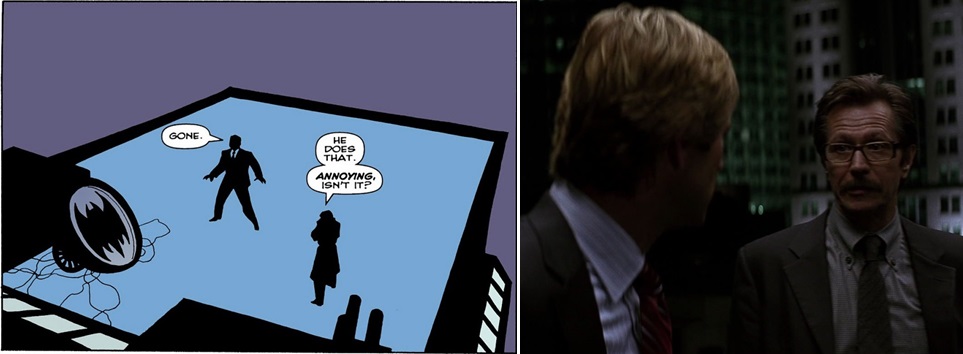
The Ledger Joker primarily uses knives, guns, poison and explosives rather than the more comical weaponized pranks of his cinematic predecessors. The Golden Age Joker mostly used these methods during his earliest appearances in the 1940s. The Ledger Joker also shares the Grant Morrison incarnation’s fondness for blades.
While confronting Gambol, the Joker offers the first of several conflicting accounts of his origins. This darkly humorous running gag reflects the Modern Age Joker’s propensity for reinvention in the comics. It’s an important characteristic of both the comic book and cinematic Joker’s psychological profile. One example of the Joker rewriting his origins can be found in The Killing Joke, where he casts doubt on his own back story with the following remark:
“If I’m going to have a past, I prefer it to be multiple choice!”
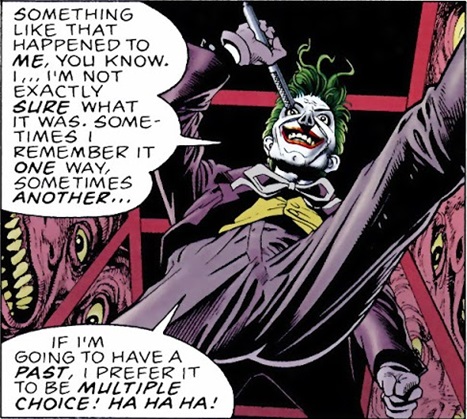
The notion of the Joker favouring multiple choice origins was reiterated in ‘The Origin of the Joker’ (Countdown Vol 1 #31, September 2007), where he offers three conflicting versions of who he was before becoming a super villain.
The Joker reinventing his past is also likely a nod to ‘The Clown at Midnight’ in which Batman discuses his psychological profile with Harley Quinn:
“He’s changed again. You know how he changes every few years. You wrote the book, Doctor Quinzel. He has no real personality, remember, only a series of ‘superpersonas.’”
The concept of ‘superpersonas’ dates back to Morrison’s earlier graphic novel Arkham Asylum: A Serious House on Serious Earth, where psychotherapist Ruth Adams postulates the Joker might suffer from a neurological disorder she terms ‘super-sanity’. Adams suggests the Joker uses this to control the sensory input he receives in order to cope with the chaos of modern life.
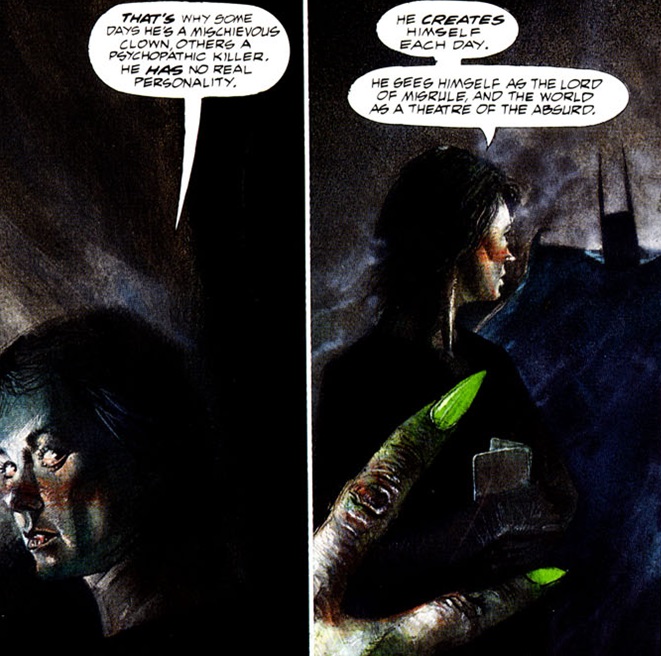
As well as frequently reinventing his back story, the Ledger Joker displays additional qualities of capriciousness in common with the comic book version. His temperament is shown to be very changeable, so that in one scene he’ll be threatening the Chechen in a coldblooded manner, while in the next scene he’ll be performing a comical double take outside an exploding hospital while dressed as a nurse. His objective also changes throughout the movie, just as the comic book Joker’s objective changes from one storyline to the next. But always the ideological end goal for both the comic book and cinematic Joker is to spread chaos, undermine order and hold up a mirror to life’s absurdities.
The false story the Joker tells Gambol about his abusive alcoholic father echoes an equally false story he told Dr. Harleen Quinzel in Paul Dini and Bruce Timm's The Batman Adventures: Mad Love (1994). In this comic the Joker claims his father was a violent drunk who used to beat him.
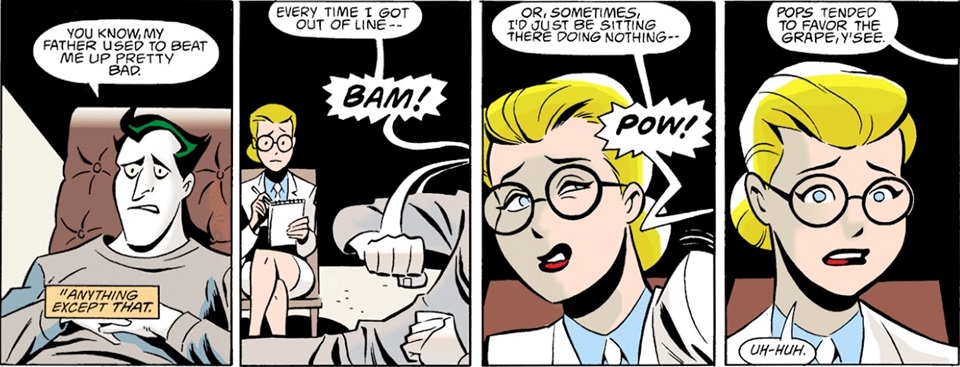
The Joker’s true origins are never revealed in the movie. This reflects the earliest comics, in which the Joker appeared fully formed without any back story or hint of his previous life. The comic book Joker wasn’t given an origin story until ‘The Man Behind the Red Hood!’ (Detective Comics Vol 1 #168, February 1951), over a decade after he first appeared.
The Joker’s preferred method of execution in the film is to slice a grin into his victims’ faces. This was almost certainly inspired by ‘The Clown at Midnight’ in which the Joker, after debuting his own Chelsea grin, attempts to carve a similar smile into Harley Quinn’s cheeks.
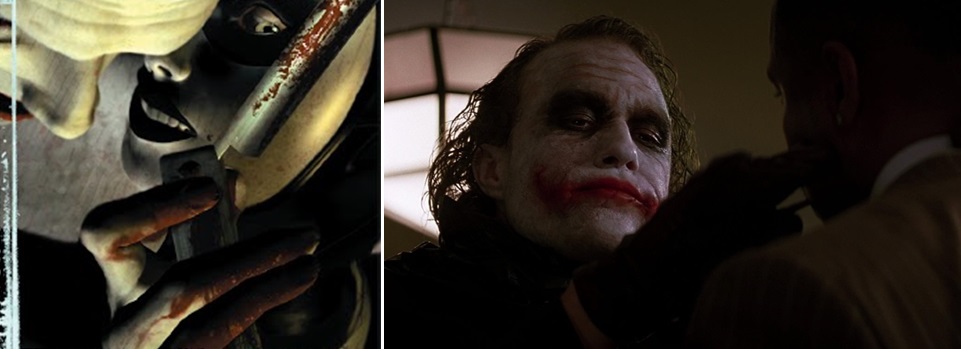
In the comics the Joker’s laughing gas leaves his victims’ corpses with smiles on their faces. The Ledger Joker also leaves his victims with smiles on their faces, only he carves them with a knife instead of using nerve agents.
While the Joker makes his mark on Gotham, Bruce Wayne travels to Hong Kong to apprehend Lau. Bruce masks his absence from Gotham by absconding with the cast of a Russian ballet, thereby using his playboy persona to create a cover story that will justify his trip abroad and provide him with an alibi. Bruce frequently makes similar use of his playboy antics to mask his crime fighting activities in the comics.
Batman debuts his new costume during the Hong Kong sequence. Lucius’ line about the new armour stopping a cat might be a nod to the comic book character Catwoman, who would subsequently appear in Nolan’s next Batman film played by Anne Hathaway.
Batman uses an EMP to knock out the electrics in Lau’s office building. He’s been shown to use EMP devices in the comics on a number of occasions. The following example is from Frank Miller’s Batman: The Dark Knight Strikes Again (2001-2002).

The Hong Kong sequence ends with Batman escaping from Lau’s office using a surface-to-air recovery system. Batman uses the same method to escape from the Gotham Waterfront Project in ‘City of Crime, Part XII: The Big Show’ (Detective Comics Vol 1 #814, February 2006).

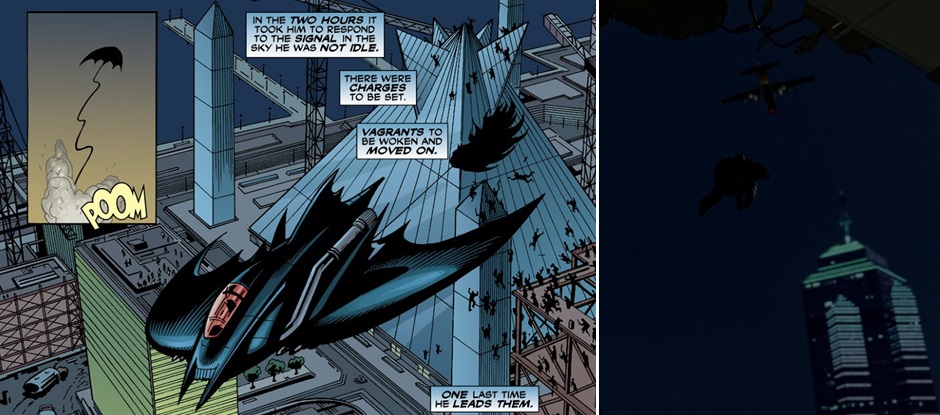
Batman takes Lau back to America and leaves him tied up outside the police station with a note for Gordon. The Golden Age Batman frequently delivered crooks to police headquarters in the same manner. The following example is from ‘Frenchy Blake’s Jewel Gang’ (Detective Comics Vol 1 #28, June 1939).
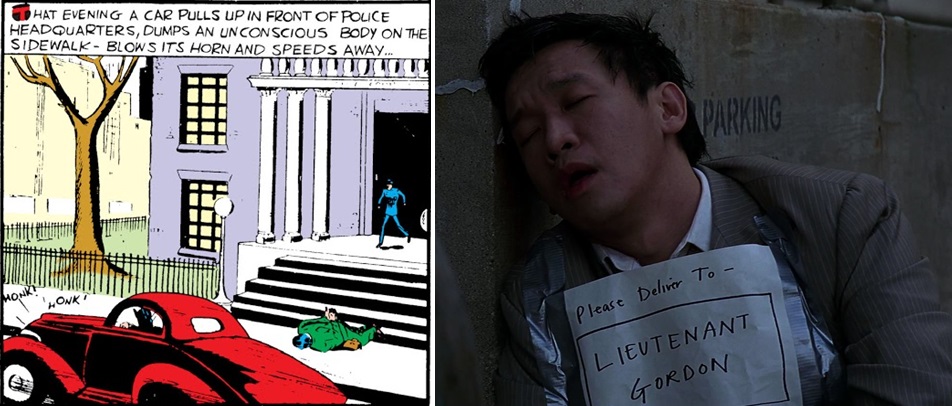
The image of the dead Batman imposter hanging by the neck with the Joker card stuck in his chest has numerous precedents in the comics. In ‘Night of the Reaper!’ (Batman Vol 1 #237, December 1971), by Dennis O’Neil and Neal Adams, Robin finds a corpse dressed as Batman pinned to a tree with a blade. ‘The Many Deaths of the Batman’ (Batman Vol 1 #433-435, May-July 1989), by John Byrne and Jim Aparo, features a villain who dresses his victims in Batman costumes and then displays their bodies in public. The villain in Dark Victory hangs her victims by the neck with clues to her identity pinned to their bodies.
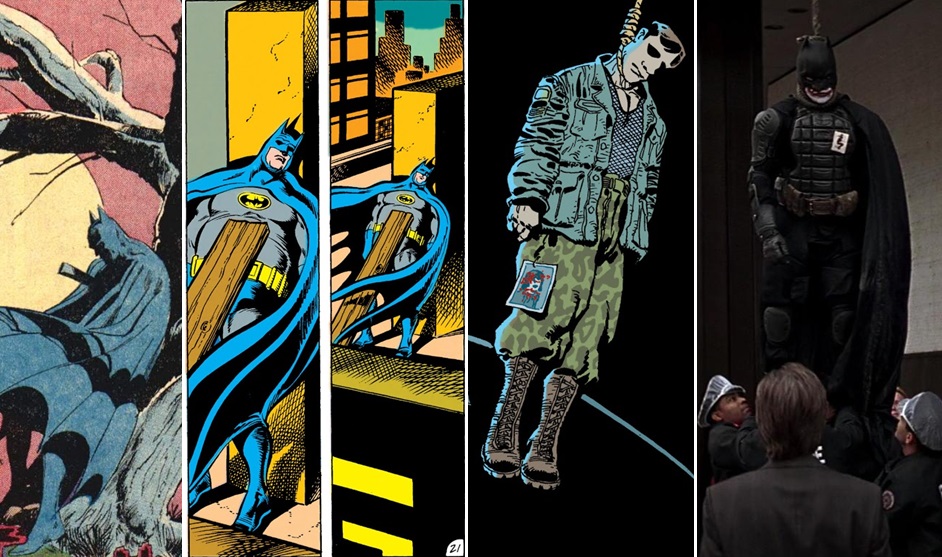
The image of a dead body dressed as Batman with a Joker grin on its face can also be found in ‘Sign of the Joker!’ (Detective Comics Vol 1 #476, April 1978).
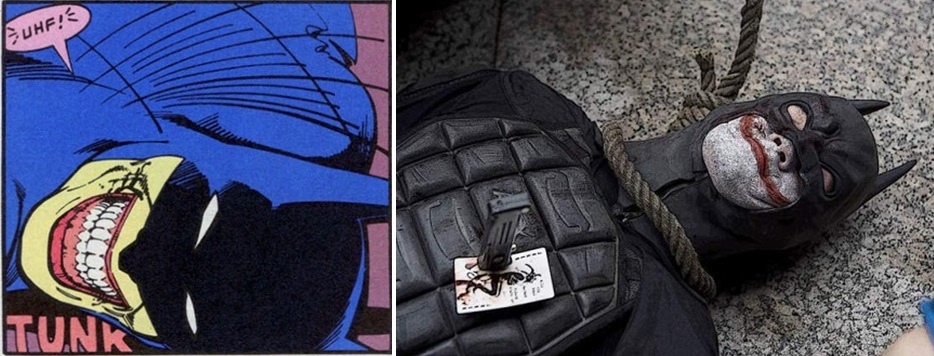
Joker sends a video to the press in which he murders the copycat vigilante and announces his intent to go on killing unless Batman reveals his secret identity. The idea of the Joker broadcasting his plans to the people of Gotham dates back to the very first Joker story from Batman Vol 1 #1. Originally he hijacked radio waves to announce his plans, while in later comics he uses television. The following panel is from ‘The Laughing Fish!’ (Detective Comics Vol 1 #475, February 1978).

The headline displayed on screen during the news report of the copycat’s death reads: “Batman dead?” ‘Batman Dead’ is also a newspaper headline featured in ‘The Many Deaths of the Batman’.
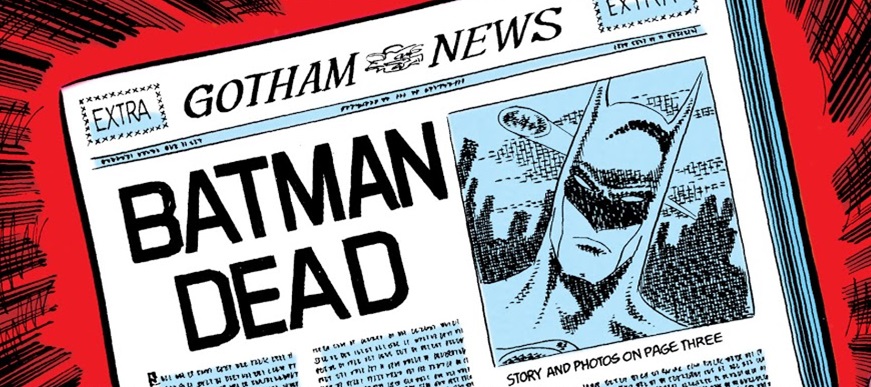
Dent’s re-election fundraiser was likely inspired by a similar sequence from Dark Detective II where a fundraiser is thrown for Evan Gregory in his bid to become state governor. Both parties are staged at swanky downtown venues.
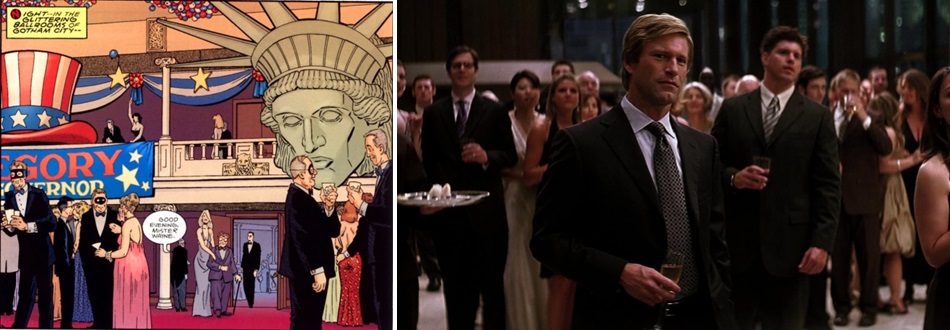
Bruce Wayne is present at both fundraisers. In the film Bruce says the line “I believe in Harvey Dent” while explaining his reasons for supporting Harvey’s re-election. Bruce also says this line in The Long Halloween. The slogan is repeated several times in both The Long Halloween and The Dark Knight and featured heavily in the latter’s viral marketing campaign.
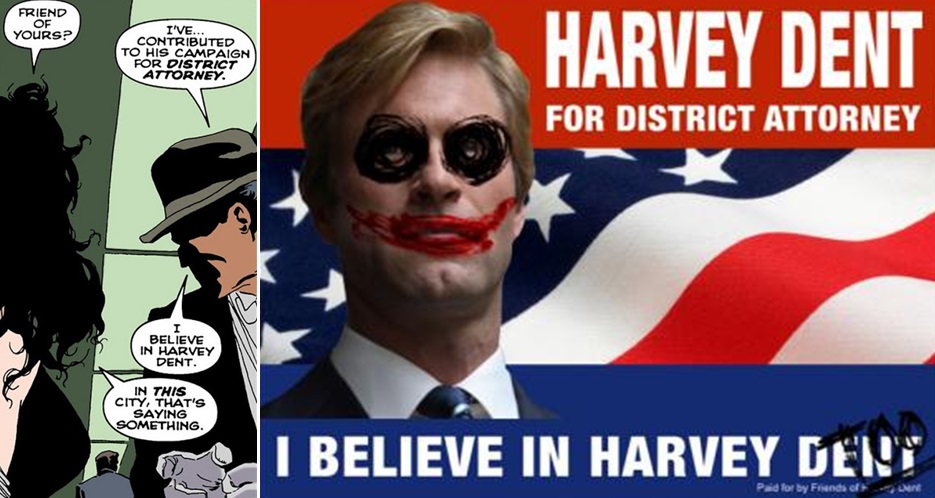
Bruce has a heartfelt conversation with Rachel about their past relationship, as he does with Silver during Evan’s fundraiser in Dark Detective II.

The love interest in both Dark Detective II and The Dark Knight is torn between the two men in her life. In the comic Silver eventually chooses Bruce over Evan, while in the movie Rachel chooses Harvey over Bruce.
At one point Bruce surreptitiously pours his champagne over the balcony when no one is looking. Bruce does not drink alcohol in the comics either but will sometimes pretend to for the sake of maintaining his playboy persona. The following panels are from ‘Year One: Poison Ivy’ (Batman: Shadow of the Bat Annual Vol 1 #3, 1995).
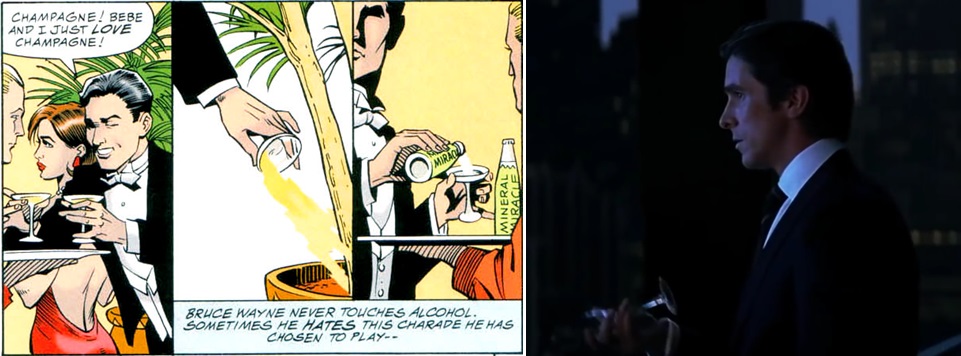
While the fundraiser is underway, the police analyse the playing card that was stuck to the dead Batman copycat and discover it is marked with the fingerprints of three people: Judge Surillo, Commissioner Loeb and Harvey Dent. The idea of the Joker announcing his victims in advance and challenging the police to stop him dates back to his debut story in Batman Vol 1 #1.
Gordon and his men surround Loeb (Colin McFarlane) in an effort to protect him, but the Joker manages to kill the commissioner using poison. This recalls how Henry Claridge was killed in the Joker’s debut story and The Man Who Laughs.

In the comics Loeb was killed by the Hangman in Dark Victory. In the movie the Joker kills him.
The scenario of someone targeted by the Joker being poisoned while under protective custody has been reused in several later stories, including ‘The Laughing Fish’, The Man Who Laughs and Dark Detective II.
Judge Surillo is also killed, only in her case the Joker uses a car bomb. The blast scatters Joker playing cards all over the scene. These have been the Joker’s preferred calling card in the comics since his debut story in 1940.
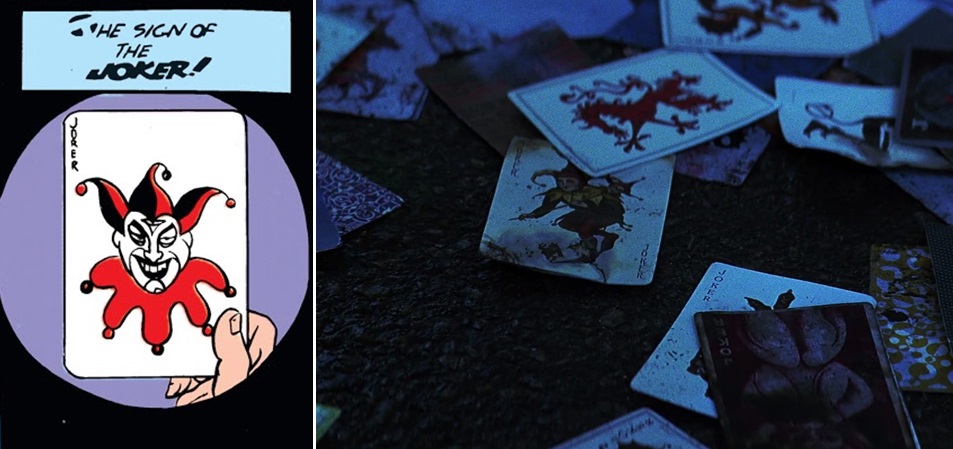
At the same time this is happening, the Joker crashes Harvey’s fundraiser. He also crashes Evan’s fundraiser in Dark Detective II. In both stories he addresses his captive audience while the guests stand frozen in fear.

Bruce slips away from the party and ducks into a secret panic room where his weapons and Batman costume are stored. When Bruce lived in a penthouse during the Bronze Age, he had a hidden elevator in the Wayne Foundation Building with which he could quickly access the Batcave. His panic room in the film might be an allusion to this.
It’s during the fundraiser scene that the Joker delivers the second of his multiple origin stories. This one describes him cutting the smile into his own face in order to bring his appearance in line with that of his disfigured wife. This story was almost certainly inspired by a scene from ‘The Clown at Midnight’ where the Joker reveals his new facial scars to Harley Quinn and tries to carve an identical smile into her own features.
“I’ll let you live, but it would be better if you looked like me.”
[...]
He tilts her chin up and gently trails a bloody razor’s edge down the soft, fuzzy peach skin of her cheek. Harley closes her eyes and bites her trembling lip as it turns to jelly.
“Do it,” she whispers. “If that’s what you want...”

Batman comes to the rescue in both the movie and Dark Detective II. He enters the scene in the comic by delivering a one-liner from off panel: “You’ve been recalled, Joker.” He enters the scene in the movie by delivering a one-liner from off screen: “Then you’re gonna love me.” In both the comic and the movie, Batman and the Joker then fight in front of the frightened guests. Evan/Harvey has already been rendered unconscious by this point in both scenes.
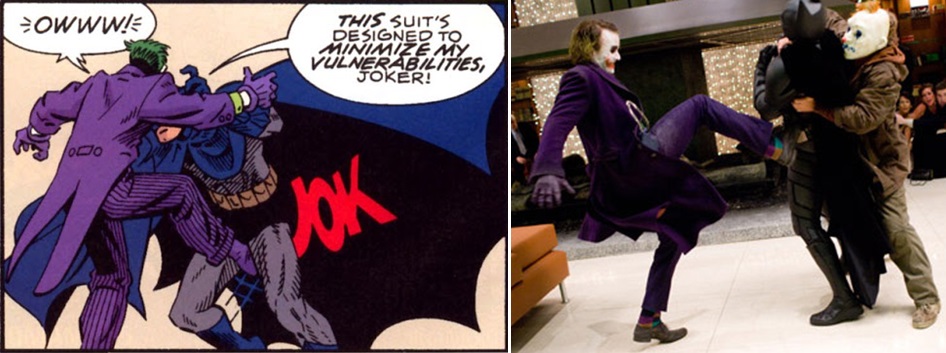
Batman’s first face-to-face encounter with the Joker ends with the Dark Knight leaping out of a window and plummeting to street level in an effort to save Rachel. Their first one-on-one fight in Batman Vol 1 #1 ends with the Joker knocking Batman off a bridge and sending him plunging into a river. In both stories the Joker emerges victorious and makes a clean getaway.
The image of Bruce contemplating multiple images of the Joker displayed on the Batcomputer has been used in several comics. The examples below are from The Killing Joke and The Man Who Laughs.

Batman struggles to understand the Joker’s motives in the film, as he does when he first encounters him in The Man Who Laughs.
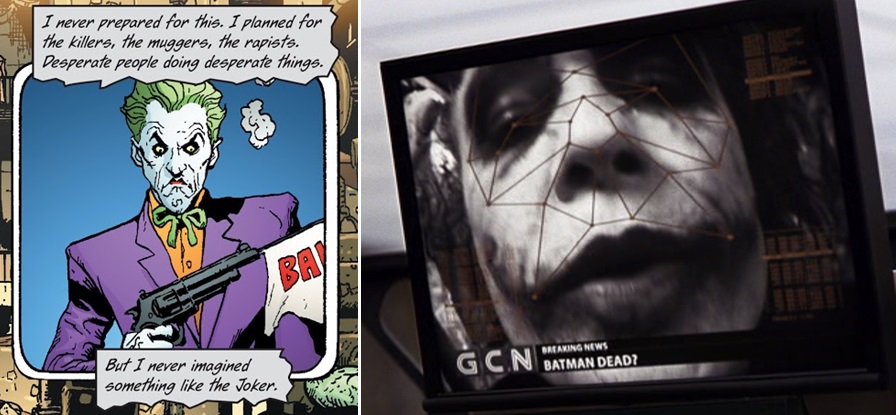
Batman is shown listening in on police radio frequencies using a receiver inside his cowl. Batman’s cowl contains similar radio equipment in the comics. The following panel is from 'Endgame, Part III: ...Sleep in Heavenly Peace...’ (Detective Comics Vol 1 #741, February 2000).
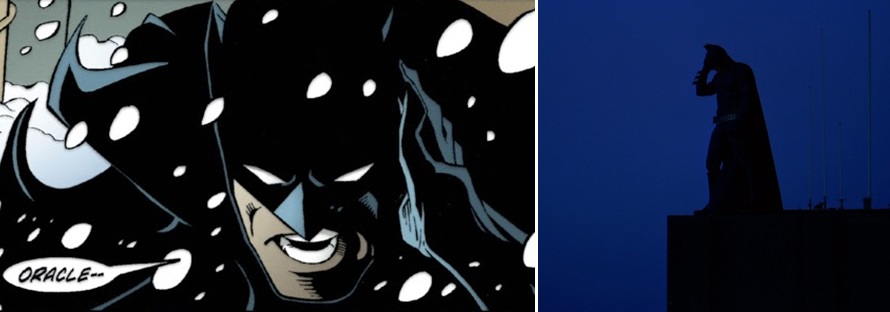
The police dispatcher leads Batman to the scene of the Joker’s latest crime. There he and Gordon find two dead bodies slumped over a table holding playing cards. The Joker has left identical crime scenes in his wake in many comics, as seen in this example from ‘Death Has the Last Laugh’ (Brave and the Bold Vol 1 #111, March 1974).

Batman extracts a shattered bullet from the murder scene and takes it back to his crime lab. There he conducts ballistic tests to reconstruct the bullet and analyses it for fingerprints. He then cross-references the results against a criminal database to identify the address of the person who loaded the bullet. Bruce is also skilled at forensics, ballistic science and fingerprint analysis in the comics, though this was the first film to explicitly show him implementing these skills on screen.
Once Bruce and Alfred have identified the owner of the fingerprint, Bruce sets out on a motorcycle to check out their address. The idea of Bruce wearing motorcycle gear to follow up on a lead during the daytime was probably inspired by Batman: Year One (1987).
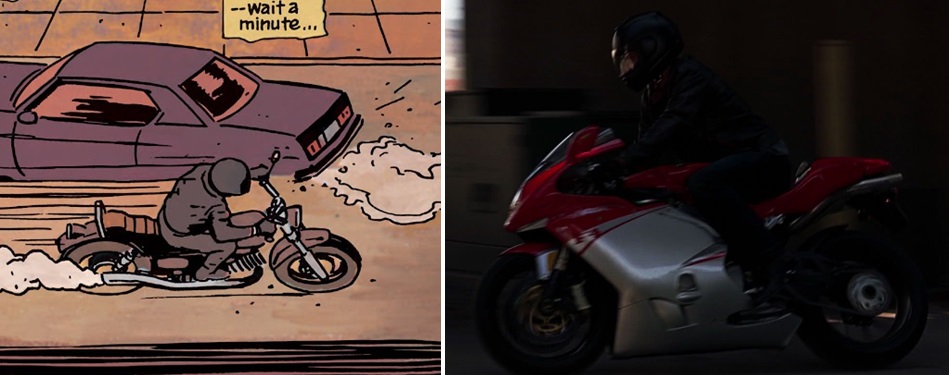
The address takes Bruce to an apartment overlooking the funeral procession of Commissioner Loeb. A police presence surrounds Mayor Garcia, but it turns out one of the officers is actually the Joker in disguise. This is yet another plot point taken from the Joker’s 1940 debut story. In the comic Judge Drake had been placed under protective custody after being named as the Joker’s next victim, only for one of the attending officers to be revealed as the Joker in disguise. In both stories, this scene marks the only time we see the Joker without his white makeup on.
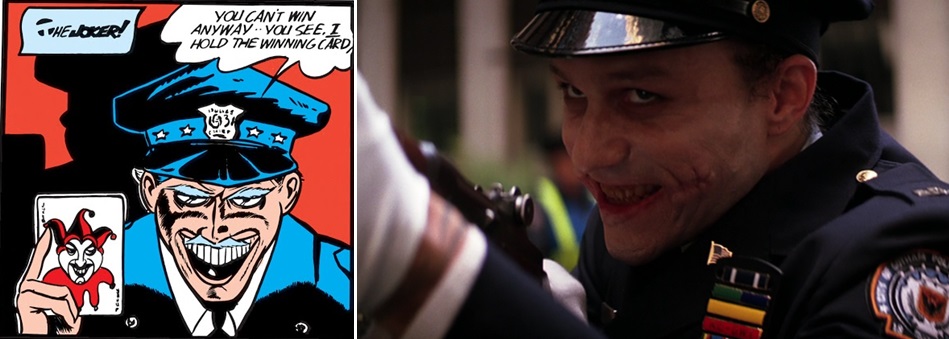
The idea of the Joker opening fire on a public procession recalls a scene from the Golden Age story ‘The Cross-Country Crimes’ (Batman Vol 1 #8, December 1941).

Gordon is struck by the Joker’s bullet and seemingly killed. It’s later revealed he is still alive and merely feigned death in order to protect his family from the Joker. This plot point is taken from The Long Halloween, where Harvey Dent pretended to be dead after surviving an attempted mob hit on his family home.
Gordon was also shot by the Joker while trying to protect one of his targets in The Man Who Laughs.
Following Gordon’s “death”, Batman drags Maroni to a darkened alleyway and interrogates him. He also interrogated Maroni in a darkened alleyway in The Long Halloween.

The scenario of Batman dangling a suspect from an elevated height in order to intimidate them has been used many times in the comics. The following example is from ‘Under the Hood, Part II: First Strike’ (Batman Vol 1 #636, March 2005).
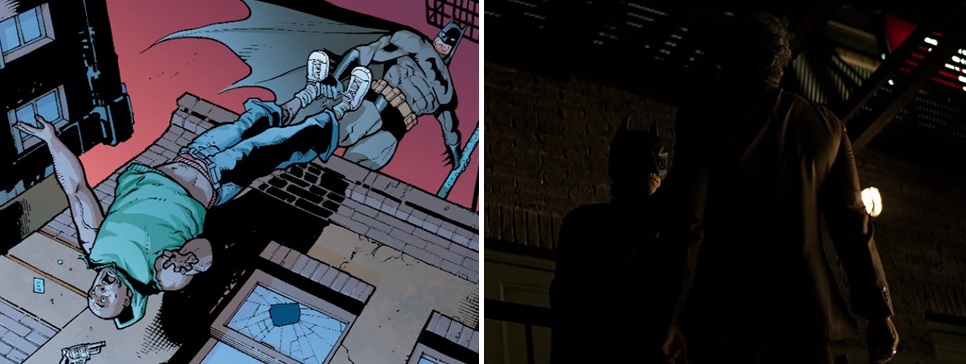
The sequence where Gordon and Batman draw out the Joker using Dent as bait is inspired by a sequence from The Long Halloween where they use the transfer of Maroni to lure out the Holiday Killer.
Harvey gives his coin to Rachel before he boards the police transport vehicle. She then learns it is a trick coin with two heads, just like his father’s coin in the comics. The following panels are from Batman Annual Vol 1 #14.
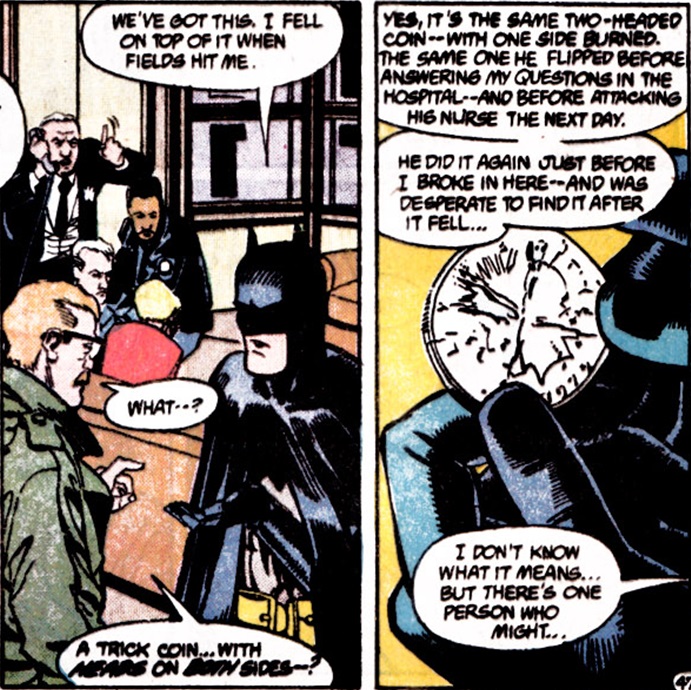
The Joker attacks the convoy and fires an RPG at the police transport. He fires a similar weapon from a moving truck in ‘Gotham’s Cleverest Criminal’ (Batman Sunday Newspaper Strip by the McClure Syndicate, 28th October-9th December 1945; later reprinted in Batman Vol 1 #187, January 1967).
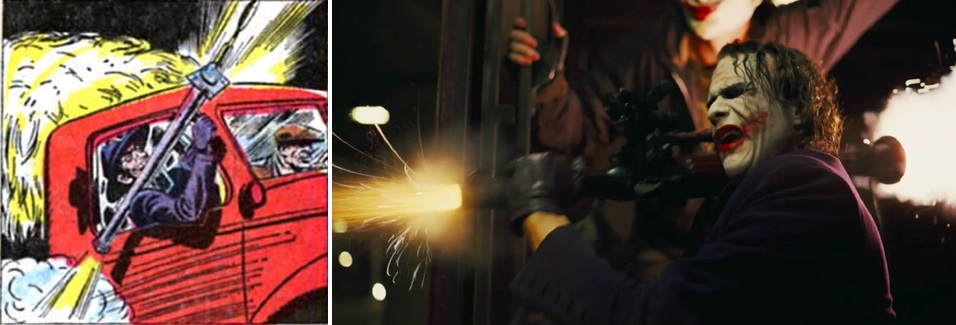
Batman uses the Tumbler to shield the other vehicle from the Joker’s attack. The comic book Batman uses the Batmobile to block a drive-by shooting on another vehicle in ‘Murder Comes in Black Boxes!’ (Batman Vol 1 #281, November 1976).

The Tumbler is irreparably damaged by the blast and Batman is forced to continue the chase using the Batpod. The Batpod is the Nolanverse version of the Batcycle, which first debuted in the comics in ‘The Batwoman’ (Detective Comics Vol 1 #233, July 1956), where it was originally ridden by Kathy Kane. The following comparison shows the Batcycle from Batman: Year 100 (2006) by Paul Pope.

The idea of the Batpod disengaging from the Tumbler may have been inspired by the Batmissile in Tim Burton’s Batman Returns (1992).
During the chase Batman commits a significant amount of property damage. He’s not above doing this in the comics when the severity of the situation calls for desperate measures. Here’s an example from The Cult where he demolishes an entire building using the Batmobile’s armaments. Note Batman's narration in this panel:
"Unlike the army, I'm not afraid to cause a little property damage."
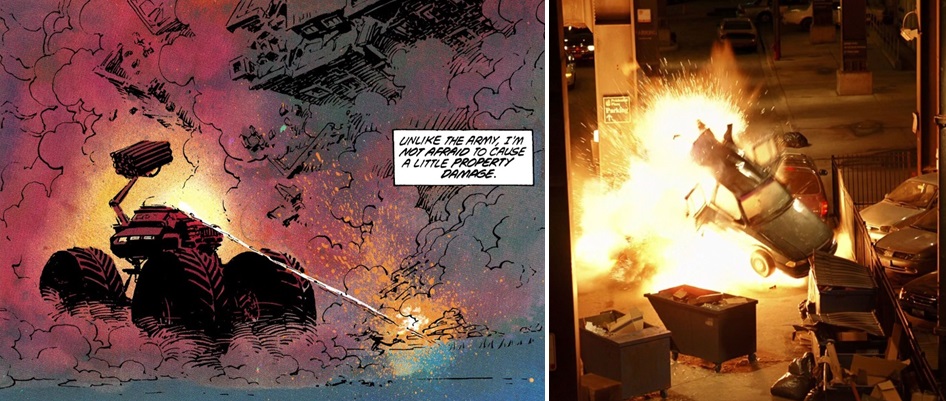
The following visual comparison is taken from ‘The Surrogate, Part II: The Blinding’ (Detective Comics Vol 1 #792, May 2004).
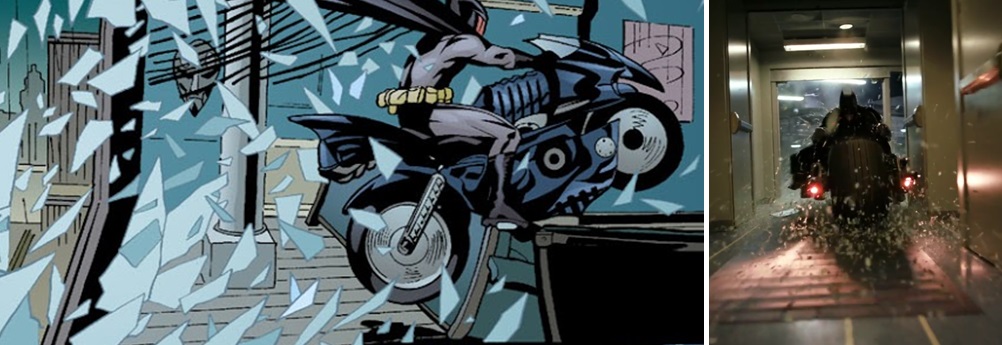
The moment where the Joker positions himself in the middle of the street and challenges the oncoming Batman to kill him is likely a nod to the finale of Tim Burton’s Batman (1989) where the Joker faces down the Batwing in an identical manner.



Batman swerves to avoid hitting the Joker and crashes the Batpod. His temptation to kill the Joker, as well as his inability to do so on account of his moral code, have both been evidenced in the comics on numerous occasions.
While Batman lies unconscious beside his crashed vehicle, one of the Joker’s goons attempts to remove his mask and in doing so triggers a defence mechanism in the Batsuit. The following comparison is with a scene from Batman: Hush (2002-2003) by Jeph Loeb and Jim Lee.

The prisoner transfer sequence concludes with the revelation that Gordon is still alive. In The Long Halloween the plot twist was that Harvey was still alive. In both stories one of the escorting police officers is revealed to be one of the main protagonists in disguise: Batman in the comic, Gordon in the movie. This character then surprises the killer and manages to subdue him.

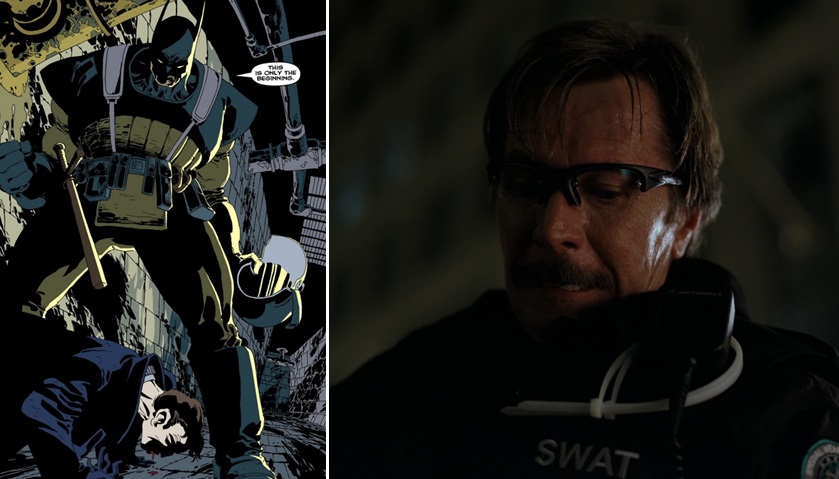
The Joker’s arrest is also reminiscent of a plot point in ‘Soft Targets’ (Gotham Central Vol 1 #12-15, December 2003-March 2004) by Ed Brubaker, Greg Rucka and Michael Lark. In Gotham Central Vol 1 #14 the Joker is apprehended by Lieutenant Ron Probson and taken to the GCPD Major Crimes Unit. The Joker wants to be captured in both the comic and the movie, though the police are unaware of this fact.
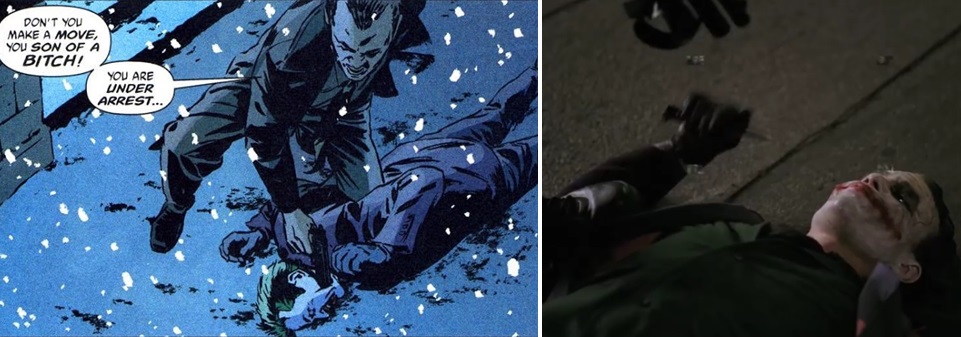
Following the successful completion of the plan, Harvey tells the press he relied on the Batman to “save my ass”. Evan expresses a similar sentiment towards Batman in Dark Detective II.
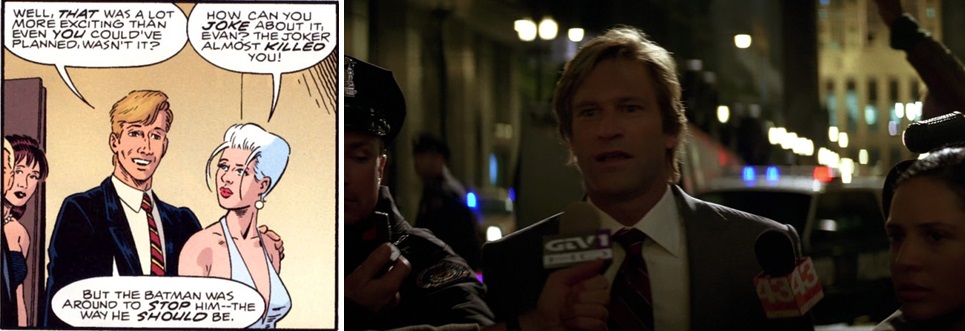
The Joker is transferred to the police station and locked behind bars. Batman sends the Joker to prison at the end of his debut story in Batman Vol 1 #1. The Joker promptly escapes that very same issue, just as the Ledger Joker escapes not long after being captured in the movie.
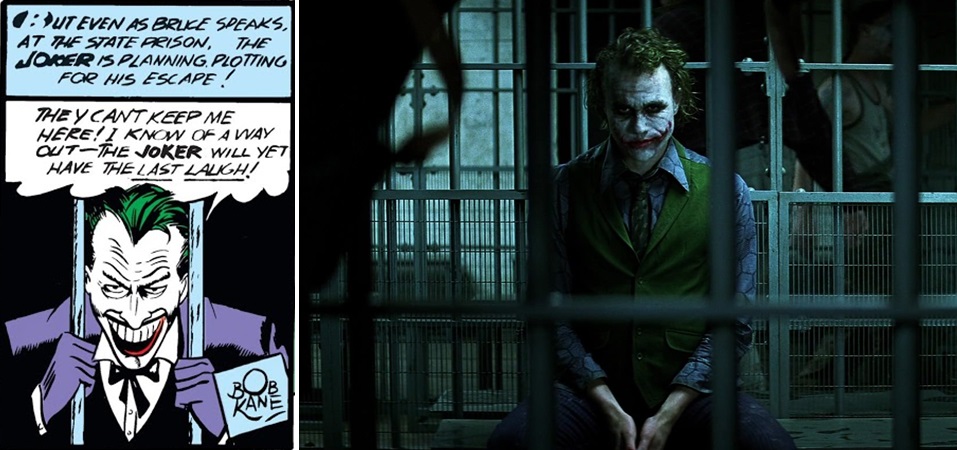
As a result of his successful capture of the Joker, Gordon is promoted to police commissioner. In the comics Loeb was succeeded by another commissioner named Grogan, who in turn was succeeded by Gordon. In the film Gordon becomes commissioner immediately after Loeb.
Gordon’s wife, Barbara (played by Melinda McGraw), is both angry and relieved when she discovers her husband is alive. In the comics Gordon’s job put a tremendous strain on their marriage, which resulted in Barbara eventually leaving Jim and taking their son James Jr. (played in the film by Nathan Gamble) back to Chicago. We find out in The Dark Knight Rises that their marriage also ended in separation in the Nolanverse.
At first it appears the Joker’s threat has been neutralised, but then the GCPD discover Rachel and Harvey have both been kidnapped. This plot point was adapted from the aforementioned Gotham Central storyline ‘Soft Targets’, in which the Joker kidnaps newscaster Angie Molina and stashes her away next to some explosives rigged to a timer. In both stories the police question the Joker in an interrogation cell, hoping to find out where he’s hidden his victim(s) before the time runs out. But in both stories the Joker refuses to cooperate.
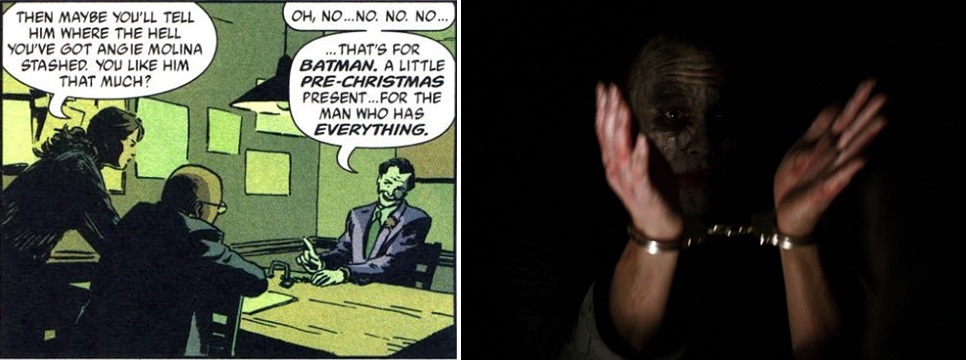
The Joker also kidnaps Silver St. Cloud in Dark Detective II. This drives Evan into a desperate frenzy, much like Harvey experiences in the movie.
Gordon brings in Batman to continue the interrogation. This sequence is visually inspired by the opening scene of The Killing Joke. In the comic Batman realises he is talking to another Arkham inmate made up to look like the Joker, while in the film he’s speaking to the real Joker. The visual similarities between the two scenes are obvious nonetheless.
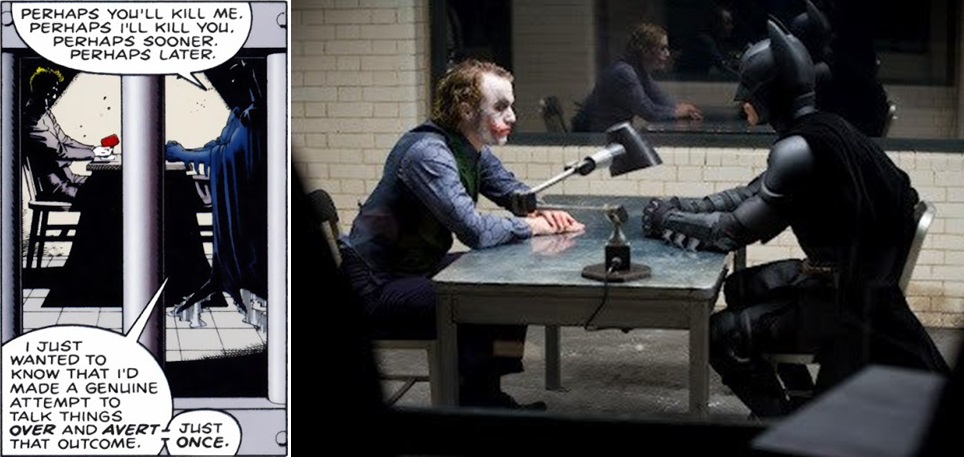
Note Batman’s “Wherrrrre is he?” line in the comic, similar to his “Where are they?” line in the movie.

The Joker’s perception of a psychological and philosophical complementarity between Batman and himself is very much routed in the Modern Age comics. At one point during the interrogation scene he tells Batman:
“I don't wanna kill you. What would I do without you? Go back to ripping off mob dealers? No. No. No! No you... you complete me.”
This echoes a sentiment the Joker expresses towards Batman in ‘The Clown at Midnight’:
“I could never kill you... Where would the act be without my straight man?”
The Joker’s “You complete me” line also recalls a comment made by the personification of Batman’s subconscious in Darwyn Cooke’s Batman: Ego (2000), where he speculates why Bruce continually refuses to kill the Joker:
“Or could it be that the great Batman needs his arch nemesis in order to feel complete?”
Ledger’s Joker also articulates the idea that societal order is illusory. This aspect of his personal philosophy has been expressed numerous times in the comics. The following example is from ‘Going Sane, Part I: Into the Rushing River’ (Batman: Legends of the Dark Knight Vol 1 #65, November 1994).
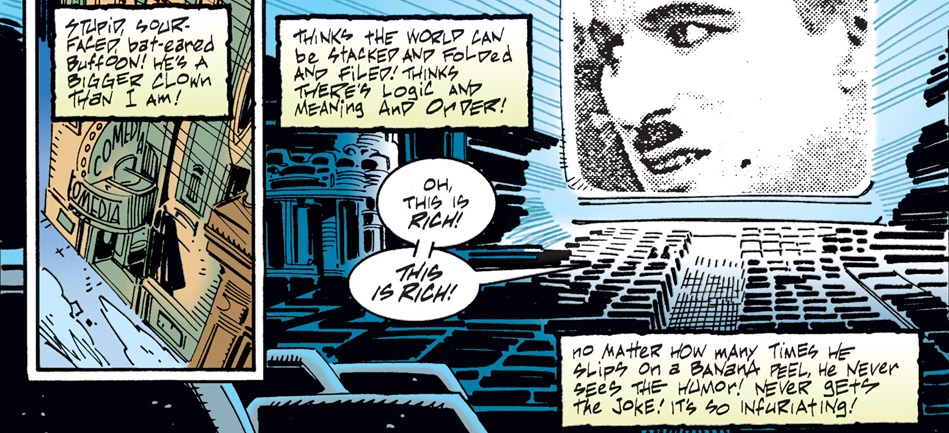
Conscious of the time running out, Batman begins to beat the Joker in an effort to get Rachel and Harvey’s location out of him. Lieutenant Probson does the same thing in ‘Soft Targets’. In the movie the Joker eventually gives up the addresses, while in the comic he refuses to do so.
The sequence where Batman beats the Joker is also reminiscent of the time Jason Todd tortured him in ‘All They Do is Watch Us Kill, Part II’ (Batman Vol 1 #649, March 2006). In both stories the Joker simply laughs in the face of his torturer’s attempts to hurt him.
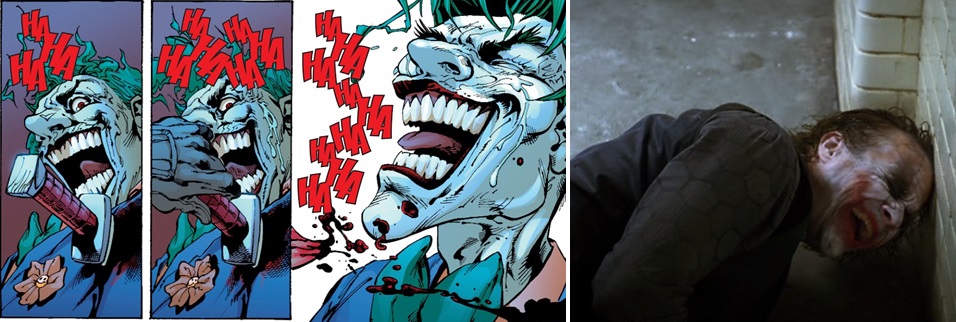
The moment where Detective Stephens rolls up his sleeves as he prepares to beat the Joker recalls Maggie Sawyer doing the same thing in ‘Soft Targets’. But in the comic Probson steps forward to rough up the Joker on her behalf.
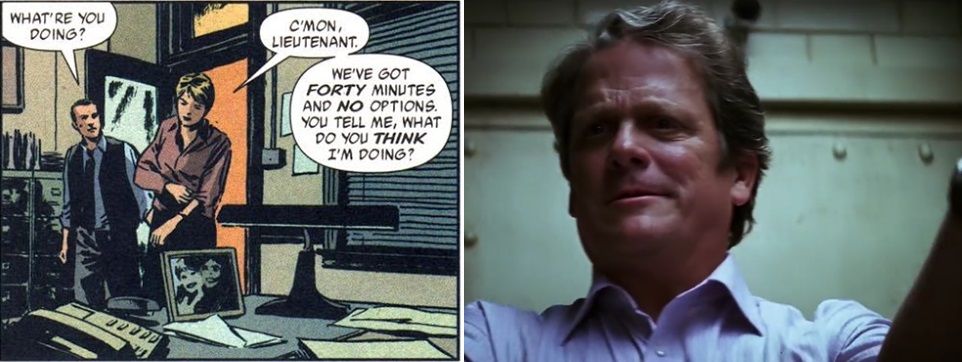
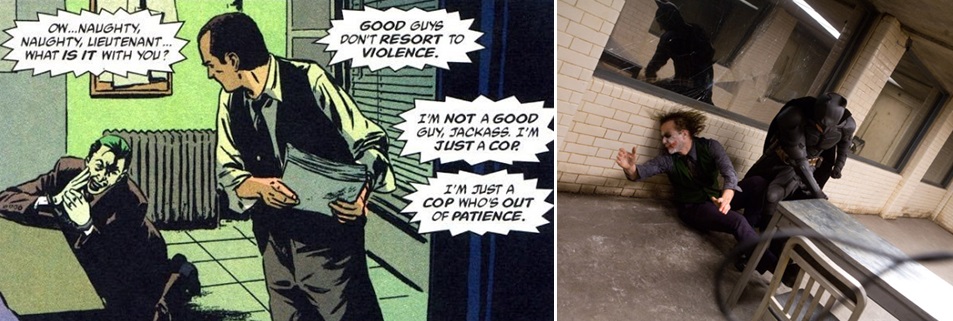
In both stories the Joker taunts the cops about the friends of theirs he’s hurt.
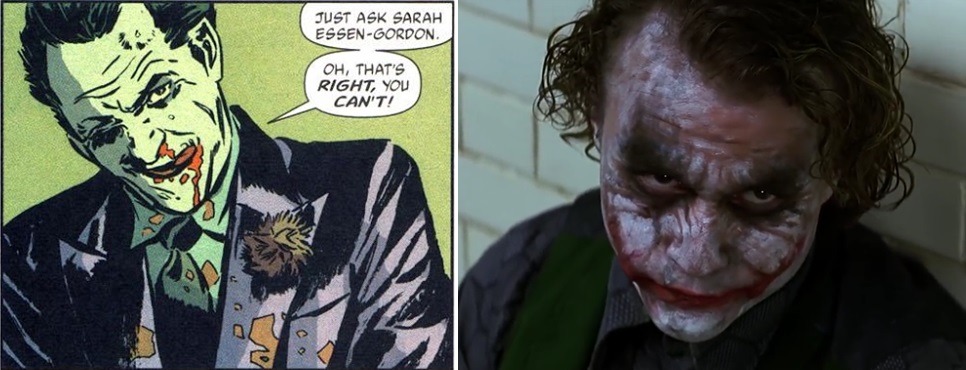
And in both stories he overpowers the cop who is beating him and escapes from the interrogation cell.
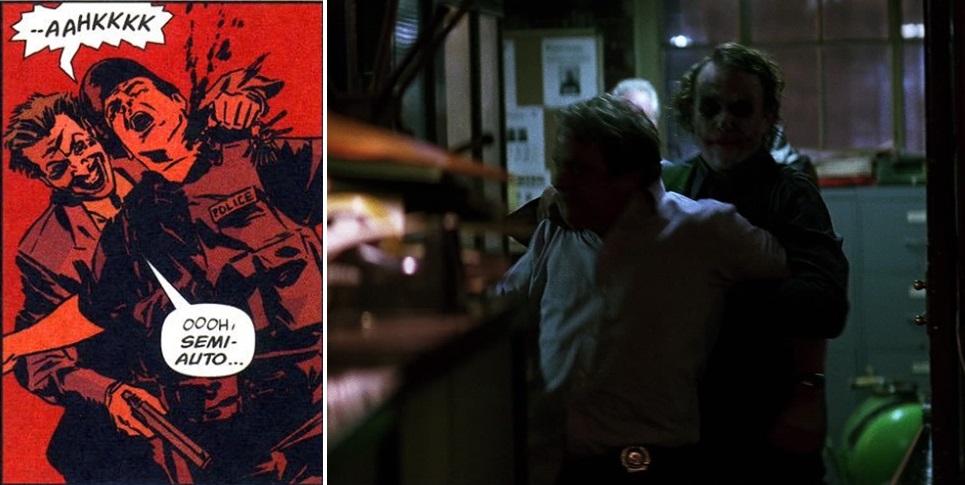
While Batman races to save Rachel, Gordon goes after Dent. With the clock ticking, Gordon mounts the curb to circumvent the heavy traffic. GCPD officers Romy Chandler and Nate Patton do the same thing in ‘Soft Targets’ as they race to save Molina.

Back at police headquarters, the Joker makes his escape with the aid of an explosive device he’d hidden inside the belly of one of his goons. The first time the Joker was imprisoned in the comics he escaped using an explosive device he’d hidden inside his own mouth, as depicted in ‘The Joker Returns’ (Batman Vol 1 #1, June 1940).
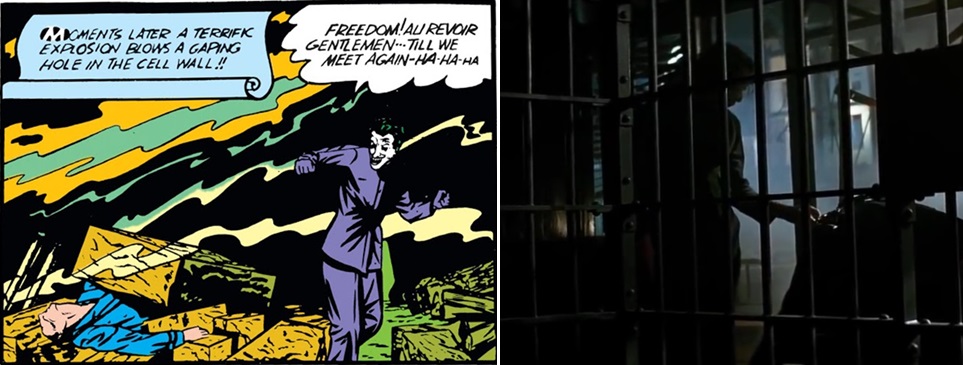
In the comic Dent was disfigured when Maroni threw acid in his face, while in the movie he is disfigured by an explosion rigged by the Joker. The idea of Two-Face receiving his scars from an explosion has a number of precedents in the comics. The earliest is the Golden Age story ‘Two-Face Strikes Again!’ (Batman Vol 1 #81, February 1954), in which Harvey, having undergone rehabilitation and reconstructive surgery, becomes Two-Face once again after having half his face burned off in an explosion.
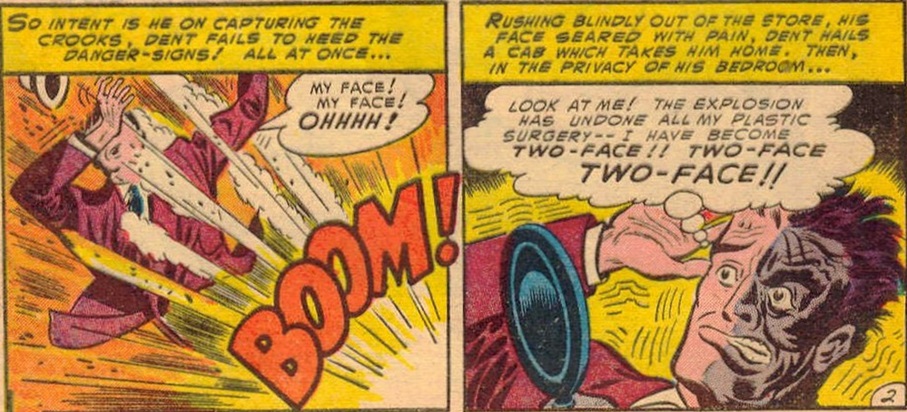
The scene in the film where Harvey is scarred is also similar to a scene from Dark Detective II, where Two-Face is returning to his hideout accompanied by an unscarred clone of himself. As he and the clone approach the entrance, a bomb planted by the Joker detonates. The blast kills the clone and leaves his corpse with half his face burned off.
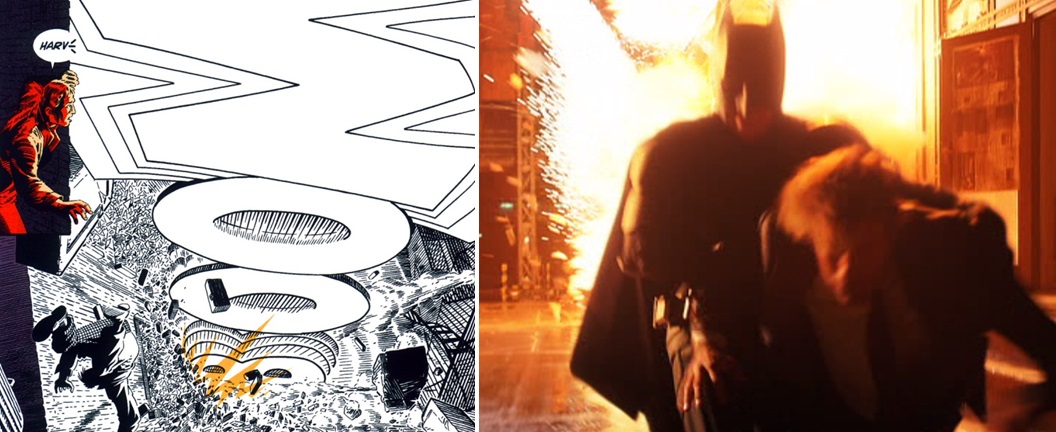
Two-Face is also injured by the Joker’s bomb in Dark Detective II. He is devastated by the loss of his clone, much like the Eckhart Two-Face is devastated by the loss of Rachel. The clone in the comic had represented Harvey’s hopes for the future, much as Rachel had in the movie. And in both stories the Joker is responsible for destroying those hopes.

Evan Gregory is also caught in one of the Joker’s traps in Dark Detective II and ends up becoming paralysed down one side of his body. Steve Englehart had intended for Gregory to become a villain in Dark Detective III, much like Dent does in the film, but the death of artist Marshall Rogers prevented this storyline from being completed.
The Harvey Dent in Batman: The Animated Series (1992-1995) was also scarred in an explosion, as depicted in the episode ‘Two Face Part I’ (season 1 episode 10).
The time bomb the Joker rigged next to Molina in ‘Soft Targets’ also detonates, though Batman is able to get her out of the building before it blows.
The image of Dent’s face burning is redolent of a scene from the Elseworlds story Batman: Masque (1997), where Harvey gets half his face burned off by an exploding stage light.
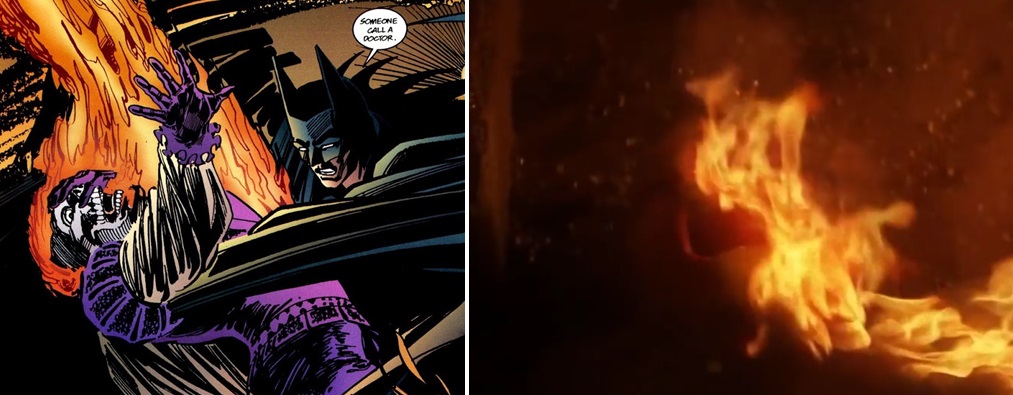
The image of Batman standing mournfully atop the smoking ruins where Rachel died evokes a similar image from Batman: A Death in the Family (1988-1989), where he surveys the ruins of the building in which Jason Todd was killed. In both scenes someone close to Batman has recently been murdered by the Joker, and Batman failed to get there in time to prevent this from happening.
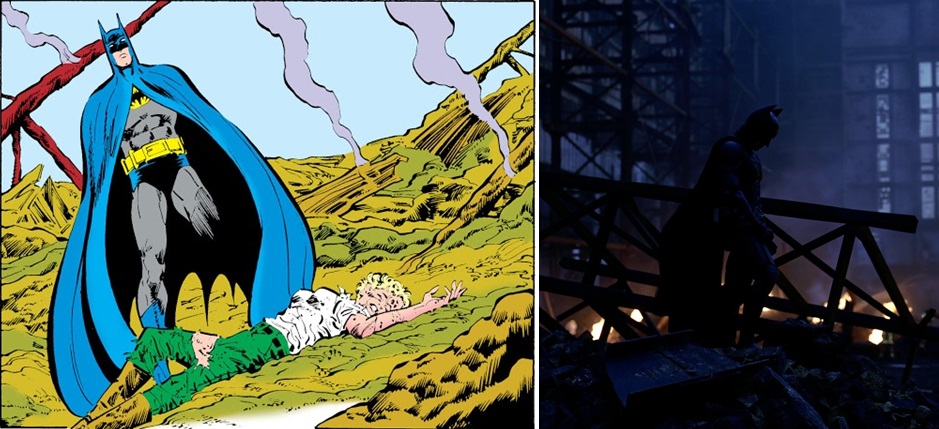
Batman then goes to visit Harvey in hospital. Batman also visits Two-Face in hospital in Dark Detective II while the latter is recovering from the injuries he sustained from the Joker’s explosive trap. The Two-Face in the comic is grieving for his clone, while the Two-Face in the movie is grieving for Rachel.
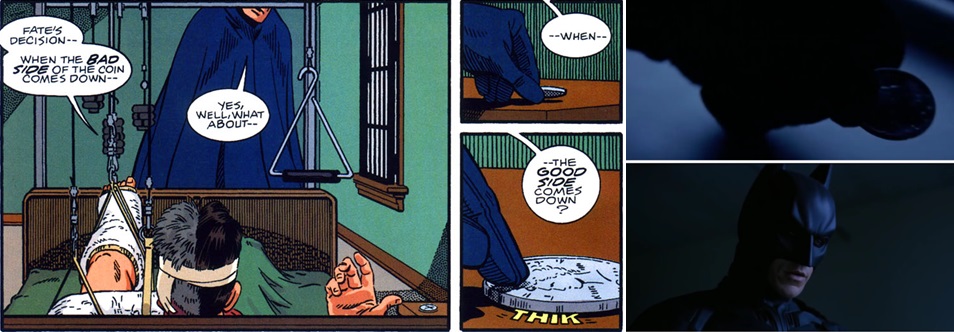
Batman also visits Dent in hospital after he is scarred in Batman Annual Vol 1 #14.
While Bruce dwells on his failure, Alfred attempts to console him. Pennyworth has comforted a dejected Bruce many times in the comics. The following example is from Batman: Venom (1991).
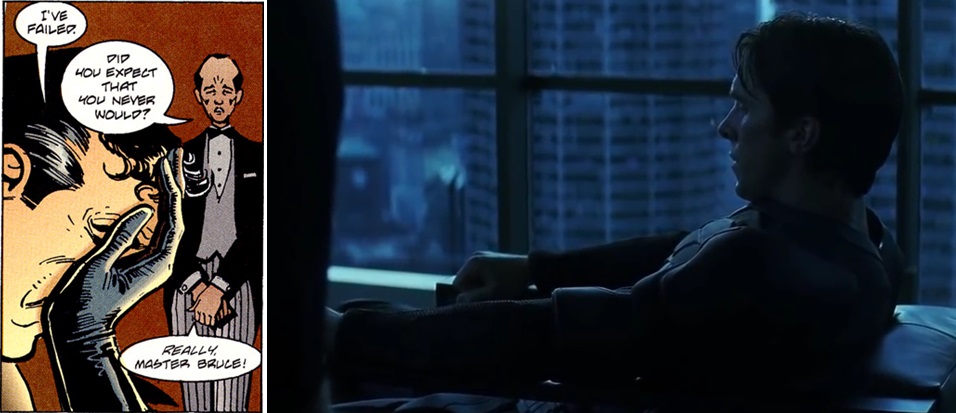
The scene where the Joker burns his share of the mob money is visually inspired by a scene from The Long Halloween where Batman and Dent set fire to a warehouse filled with mob money.
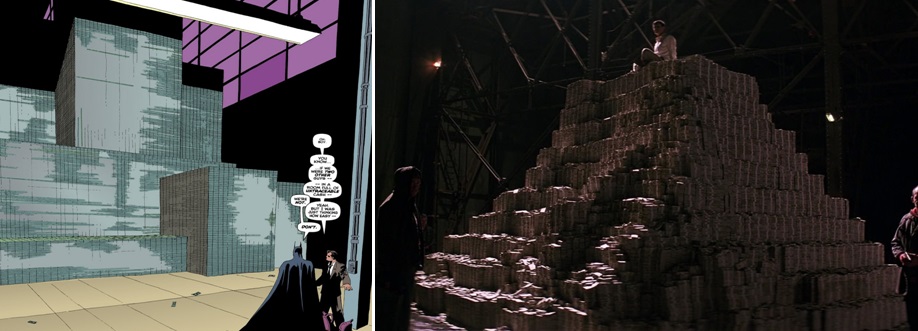
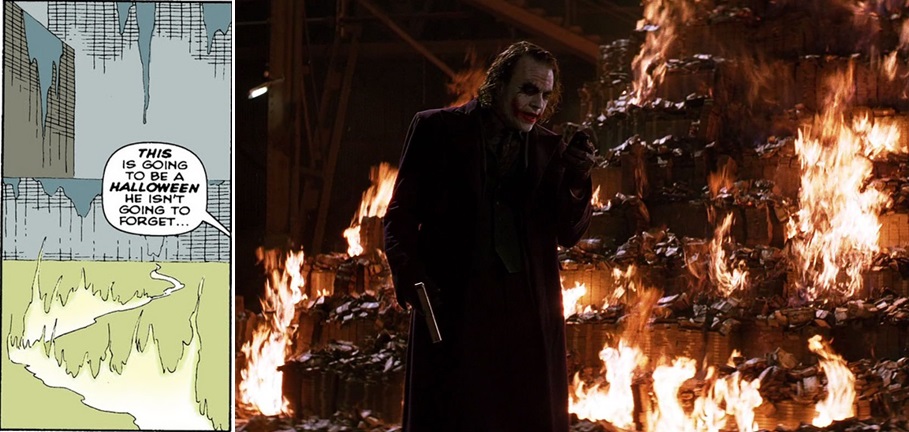
Following this scene, the Joker phones a live TV show and announces he no longer wants Batman’s secret identity revealed, despite previously demanding the Dark Knight unmask himself. His changeability here is again typical of the comic book Joker’s caprice. In the comics he had the chance to unmask Batman back in ‘Laugh, Town, Laugh’ (Detective Comics Vol 1 #62, April 1942), but changed his mind and decided not to.
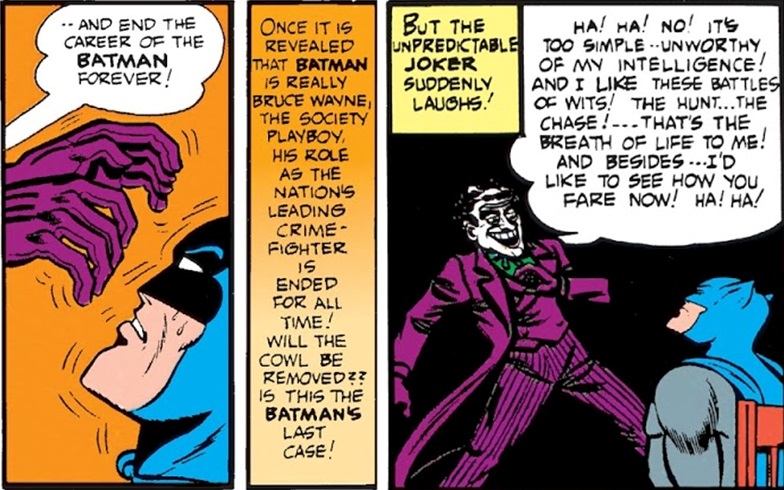
The Joker makes a public announcement revealing he’s planted explosives in one of the city’s hospitals. This prompts a mass panic, during which the Joker – disguised as a female nurse – sneaks into the hospital where Harvey is being held. Grant Morrison had originally intended for the Joker to dress as a woman in Arkham Asylum: A Serious House on Serious Earth, but the idea was rejected by the editors at DC Comics. In his original draft, Morrison introduced the Joker with the following description:
“He is dressed as ‘Madonna,’ in a black basque, seamed tights and lace-up stiletto boots (From ‘Open Your Heart’ video). His face is a grinning horror mask of powder and paint – his eyes are heavily made up with kohl eyeliner, mascara and false eyelashes. His lips are a screaming scarlet and his skin is whiter than bone.”
The script also describes the Joker as wearing an anarchy 'A' badge on his dress. In the movie he wears a Dent campaign sticker on his dress. The 25th anniversary edition of Arkham Asylum: A Serious House on Serious Earth includes Morrison’s original layout sketches in which he portrays the Joker dressed as a woman.
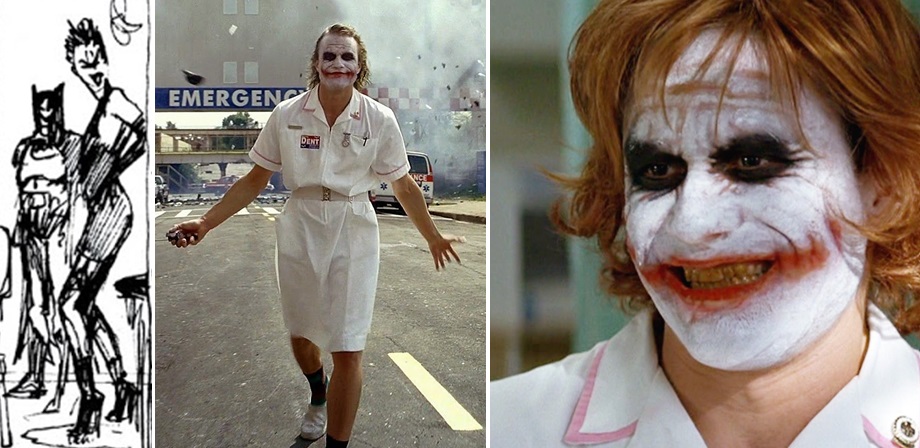
Writer Steve Englehart has claimed the hospital conversation between Two-Face and the Joker was inspired by a scene from an unproduced script he wrote for Dark Detective III:
“In the next segment, DARK DETECTIVE III, that handsome, blond, upright politician was extremely depressed over losing his left side and his woman. Then Two-Face came to him in his depression and had a heart-to-heart, in which Two-Face convinced him that life is meaningless, that the woman in his life is beyond his reach, and that that handsome, blond, upright politician should make a hundred-eighty degree turn to the dark side. Which he did.”
In the movie Two-Face flips his coin to decide the Joker’s fate. Using a coin in this manner is part of his modus operandi in the comics. He also flips his coin for the Joker in ‘Threat of the Two-Headed Coin!’ (Batman Vol 1 #258, October 1974).
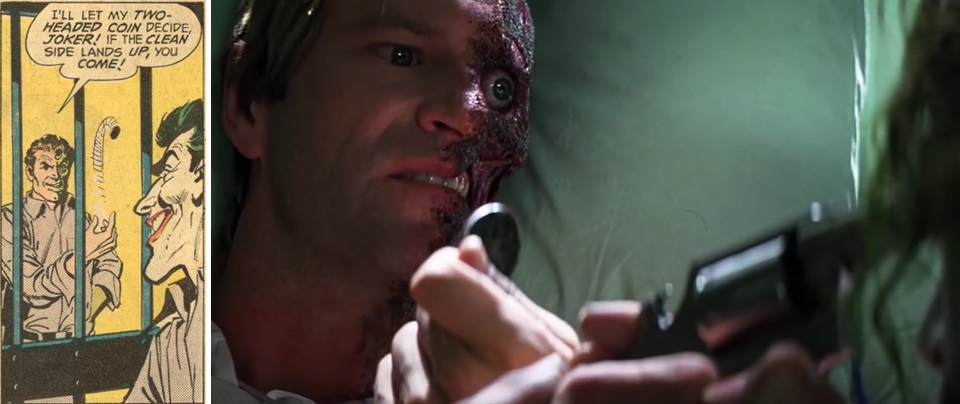
The appearance of Eckhart’s Two-Face seems to have been based on Tim Sale’s depiction of the character. Note that his red scarred side is bald, whereas most other artists portray him with a full head of hair.

Two-Face’s psychological profile is different in the film than it is in the comics. In the source material he has a split personality – one half good, the other bad – and the coin toss is used to determine which of these will govern his actions in any given situation. In the film he displays no sign of a split personality, but is instead portrayed as wholly bad after his face is scarred. He was good before he was disfigured and is bad afterwards, but never both good and bad at the same time like the comic book character. Even so, the coin toss retains both its symbolic and practical function in allowing random chance to decide the fate of his enemies.
Two-Face escapes from the hospital before it blows up and sets about hunting down the people responsible for his and Rachel’s kidnapping. His first victim in the film is a corrupt detective named Wuertz who had betrayed him to Maroni. His second victim in The Long Halloween is a member of his own office named Vernon, who had also betrayed him to Maroni. Corruption, betrayal and revenge factor into Two-Face’s origins in both stories.
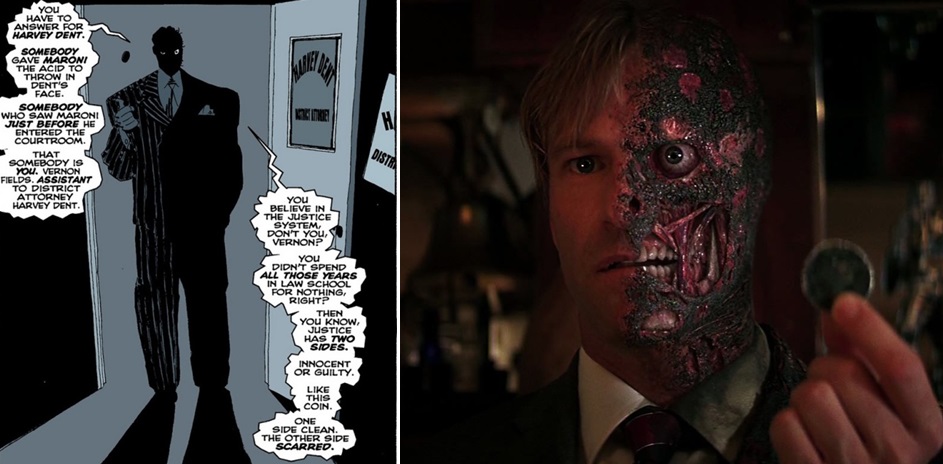
The scene where Two-Face murders Maroni by shooting the driver of his car recalls a scene from ‘Double Jeopardy’ (Batman Chronicles Vol 1 #8, March 1997). In the comic Two-Face causes a car to crash by shooting the passenger next to him and knocking out the driver sat in front. In the movie he causes the car to crash by shooting the driver in front. Two-Face survives the crash in both stories.
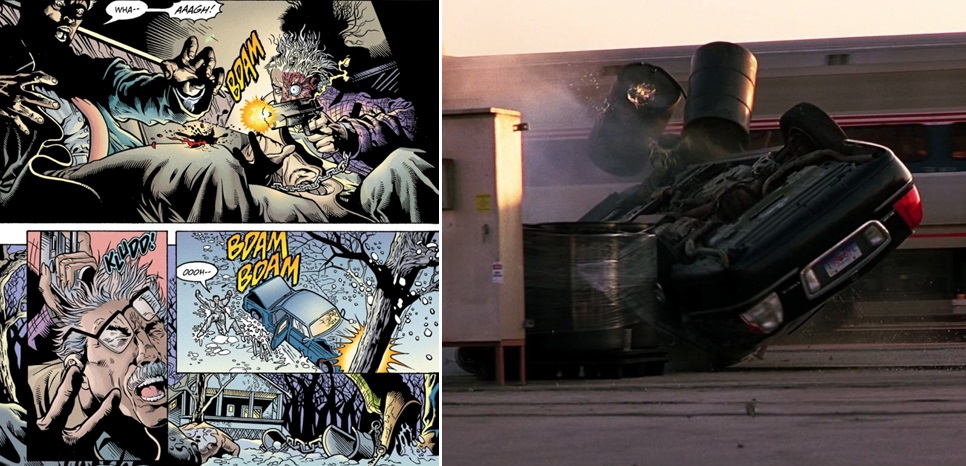
Although the plot of ‘Double Jeopardy’ concerns Two-Face hunting down Maroni, the Modern Age Dent never actually killed him. Instead Sal was murdered by the Holiday Killer in The Long Halloween. However the Pre-Crisis Two-Face did kill Maroni, as depicted in ‘Twice Dies the Batman!’ (Batman Vol 1 #329, November 1980).
The subplot about the Joker kidnapping news anchor Mike Engel is yet another element adapted from the Gotham Central ‘Soft Targets’ storyline. In the comic the Joker kidnaps newscaster Angie Molina. In both the movie and the comic the Joker records footage of the captive newscaster hanging upside down while his taunting voice can be heard in the background.

The Joker’s master plan towards the end of the film entails wiring up two boats with explosives and equipping the passengers with detonators, then threatening to destroy them both at midnight if the passengers don’t first destroy each other. The idea of the Joker’s plan climaxing at midnight is a tradition that dates back to his 1940 debut story, where he announced he would kill his victims at the stroke of midnight.
His plan also has shades of his evil scheme in the aforementioned Detective Comics Vol 1 #741. In this story the Joker holds thirty-six babies hostage, hides them next to explosives somewhere in Gotham, then challenges Batman and the GCPD to find them before he detonates the bombs at midnight.
The idea of the Joker forcing people to do things that are morally repugnant to them has also been explored in the comics. In ‘Lovers & Madmen, Part II: In Arms’ (Batman Confidential Vol 1 #8, October 2007) a pre-transformation Joker – known as ‘Jack’ – forces an artist to destroy an entire showroom of his own paintings. There are also the countless times he’s tried to provoke Batman into breaking his 'golden rule', such as in The Dark Knight Returns.
Batman and Lucius manage to track down the Joker’s whereabouts using a surveillance device that taps into people’s mobile phones. During a July 2008 Q&A podcast with Jeff Goldsmith, screenwriter Jonathan Nolan confirmed that this device was inspired by Brother Eye, an artificially intelligent surveillance satellite that Bruce built in the comics to spy on Earth’s metahuman population. In the comics this led to a breakdown of trust between Batman and the other members of the Justice League after they discovered what he’d done. The surveillance device in the movie prompts a similar dissolution of trust between Batman and Lucius. The following panels are taken from The OMAC Project (2005) by Greg Rucka and Jesus Saiz.
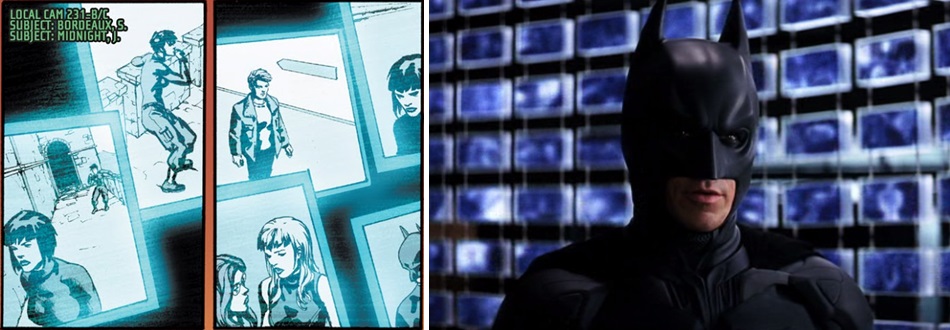
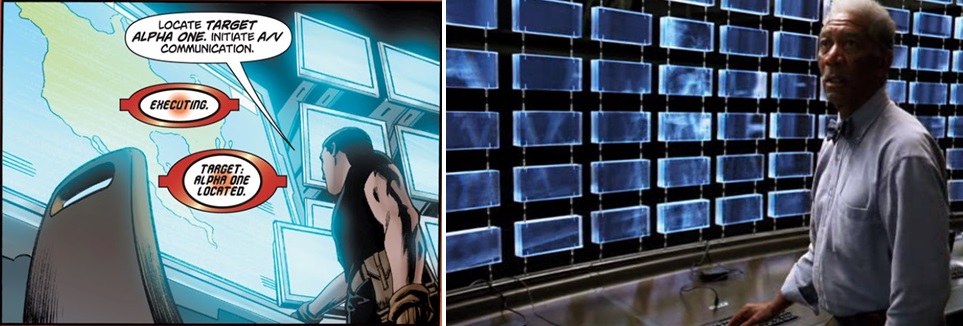
The scene where the Joker dresses his hostages in clown masks so the police will shoot them is taken from ‘Endgame, Part II: Tender and Mild’ (Batman Vol 1 #574, February 2000). In the comic the Joker tricks GCPD officer Bill Pettit into shooting his own men by dressing them as clowns. It is also during this issue that Pettit kills fellow police officer Foley, a namesake of whom would later appear in Christopher Nolan’s The Dark Knight Rises played by Matthew Modine.
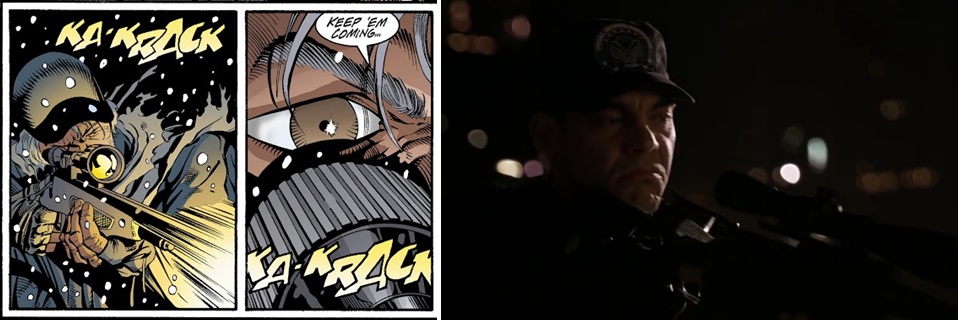
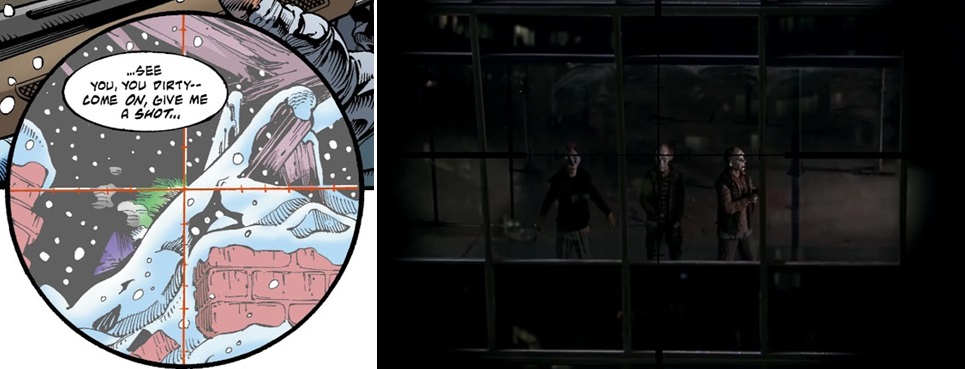
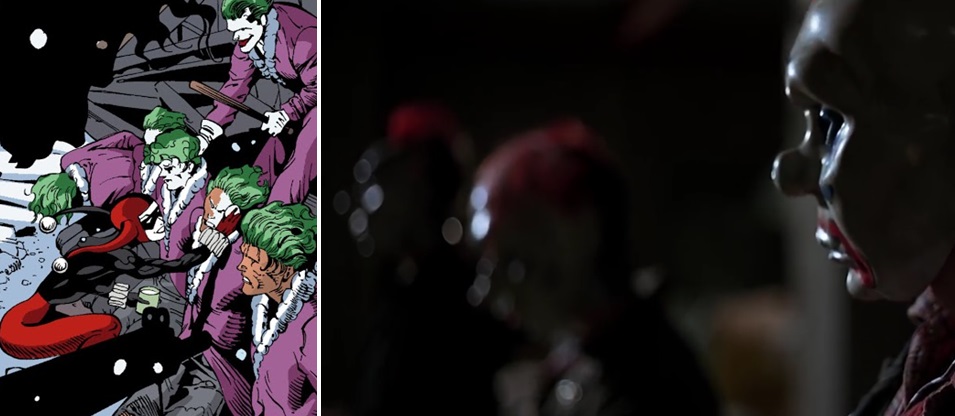
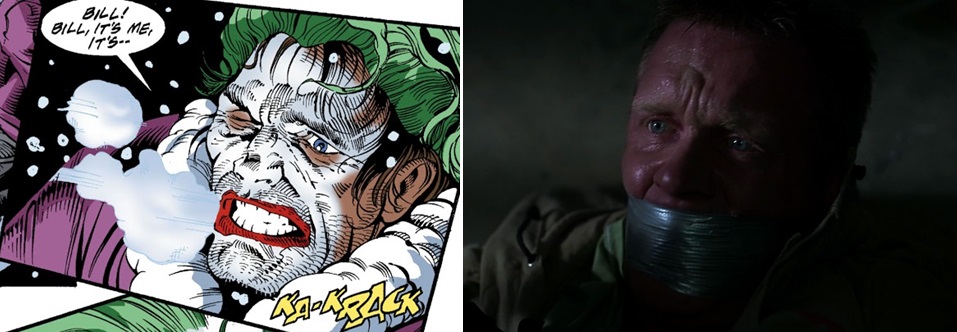
Batman races to the Prewitt Building in Midtown Gotham to stop the Joker. Once inside, he activates his suit’s sonar system. This causes glowing lenses to flip down over his eyes in such a way that resembles Batman’s glowing eyes from the comics. The comic book Batman’s costume has also been shown to feature a sonar system, as demonstrated by the following panels from ‘Franchise, Part II: The Away Team’ (Batman Vol 1 #647, January 2006).


The scene where Batman fights the SWAT team as he rushes to stop the Joker was probably inspired by the third chapter of The Dark Knight Returns.

The final fight scene between Batman and the Joker, where the latter brutally beats the former with a pipe, recalls the murder of Jason Todd in A Death in the Family, where the Joker brutally beats Robin with a crowbar. The comic book Joker frequently makes use of melee weapons whenever he and the Dark Knight come to blows.

The final showdown also recalls the finale of Tim Burton’s Batman (1989). Both films end with the hero and villain fighting atop a high building until the Joker falls from the precipice. In the 1989 film the Joker dies, while in the 2008 movie Batman saves him.
The Joker laughing as he falls to what he believes will be his death is typical of the character’s sense of humour in the comics. The following panels are taken from ‘A Gold Star for the Joker’ (Joker Vol 1 #4, December 1975).
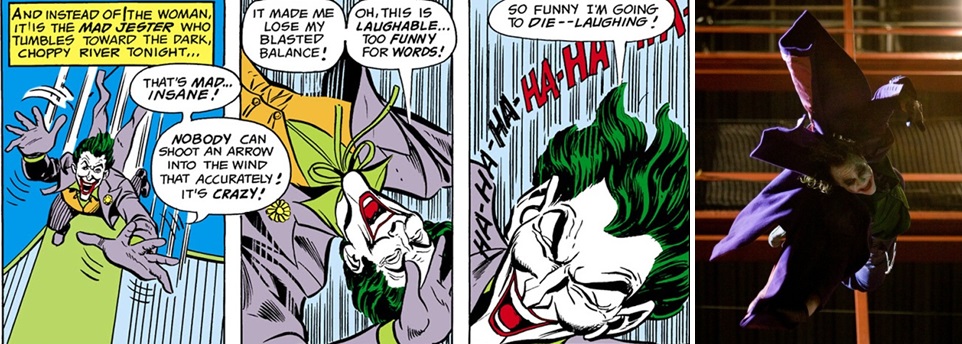
He also laughs after being fatally wounded in the aforementioned ‘The Joker Returns’ from Batman Vol 1 #1.
The final exchange between Batman and the Joker recalls the Joker’s internal dialogue during the finale of ‘The Clown at Midnight’. In the film the Joker tells Batman:
“You truly are incorruptible, aren't you? Huh? You won't kill me... out of some misplaced sense of self-righteousness. And I won't kill you... because you're just too much fun. I think you and I are destined to do this forever.”
Morrison’s story includes the following reflection from the Joker along similar lines:
“Both of us trying to find meaning in a meaningless world [...] You can’t kill me without becoming like me. I can’t kill you without losing the only human being who can keep up with me. Isn’t it IRONIC?!”
The Joker’s suggestion that he and Batman share a padded cell could be a throwback to the joke he tells in The Killing Joke about two mental patients trying to escape from a lunatic asylum. The story about the two escaped patients is widely interpreted as being a metaphor for the relationship between Batman and the Joker.
The Joker’s line “This is what happens when an unstoppable force meets an immovable object” echoes a comment he makes in Dark Detective II: “I am a force of nature –- a force of mind! And I must have a counter force.”
The Joker’s scheme to demonstrate the corruptibility of the human spirit – firstly by turning Harvey Dent into a killer, and secondly by trying to force the passengers on the ferries to murder each other – reflects his objective in The Killing Joke. In that story he tries to prove that under the right circumstances anyone can be driven insane the way he was. He tries to drive Gordon insane in the comic, while in the movie he succeeds in turning Harvey Dent into a murderous villain.
In The Killing Joke the Joker says:
“All it takes is one bad day to reduce the sanest man alive to lunacy.”
In The Dark Knight he says:
“You see madness, as you know, is like gravity – all it takes is a little push.”
Two-Face lures Gordon to the site of Rachel’s death: 250 52nd street. This address reflects the comic book Two-Face’s obsession with crimes plotted around a binary theme. For example, in The Dark Knight Returns Two-Face tries to blow up Gotham’s twin towers on the 2nd day of the month.
The finale of the movie, like the finale of The Long Halloween, sees Batman trying to prevent Two-Face from murdering someone. In the comic his victim is Carmine Falcone, while in the movie it’s Gordon’s son. In both stories Batman unsuccessfully appeals to Harvey’s sense of justice.
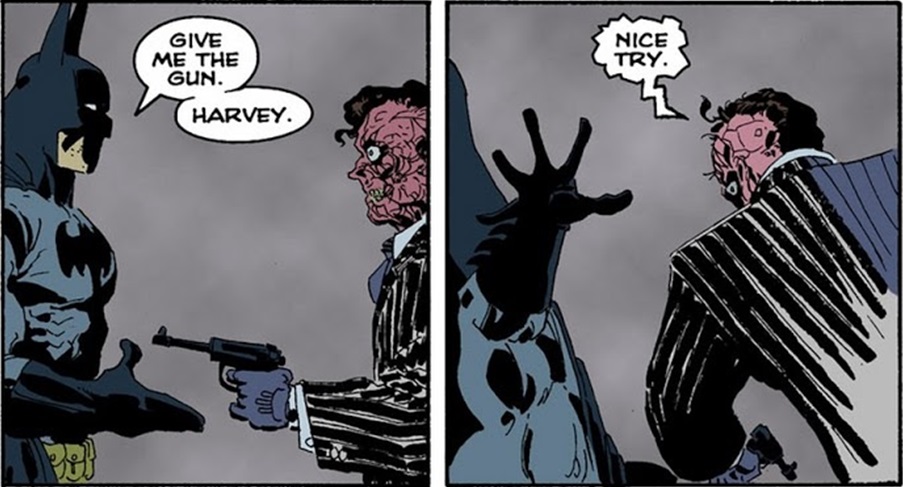
The idea of Two-Face judging Gordon for a past betrayal may have been inspired by a storyline that occurred during the No Man’s Land arc called ‘Jurisprudence’ (Batman Vol 1 #572-Detective Comics Vol 1 #739, December 1999). As in the movie, the comic book Two-Face is prepared to kill both Gordon and his family.

The moment where Batman tackles Two-Face to save Gordon’s son was almost certainly inspired by the ending of Batman: Year One. In both stories a criminal – Johnny Viti in the comic, Two-Face in the movie – kidnaps Jim’s wife and son. Viti threatens James Jr. with a knife in the comic, while Dent holds a gun to his head in the film.
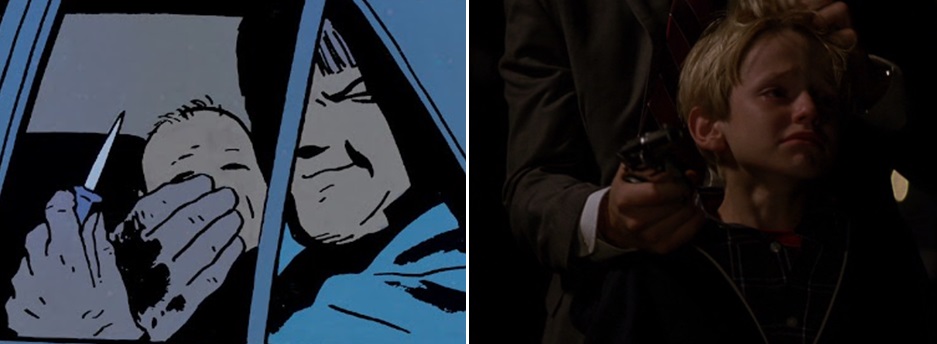
A struggle ensues, resulting in Viti/Dent, James Jr. and Batman tumbling over a precipice. In the comic Gordon falls as well. In both stories Batman catches James Jr. in the nick of time and hands him safely back to his father.
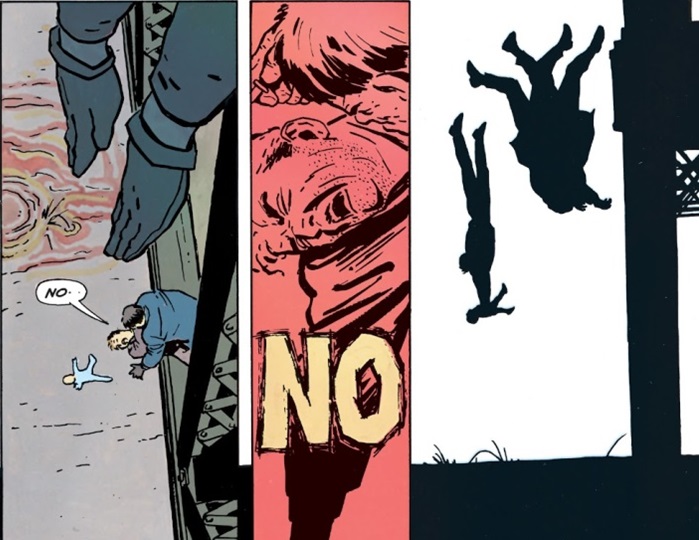

Viti survives the fall in the comic, while Two-Face dies in the movie.
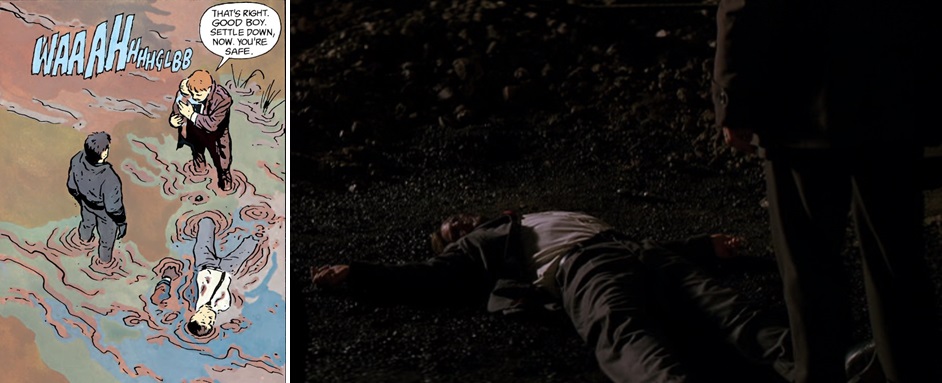
Batman takes the rap for Dent’s crimes in order to preserve the D.A.’s inspirational legacy. The idea of Batman taking the blame for someone else’s murderous acts in order to serve a greater good has also been explored in the comics. One example can be found in the inaccurately titled ‘The Only Man Batman Ever Killed!’ (Batman Vol 1 #301, July 1978), in which Batman takes the rap for the murder of Malcolm ‘The Overlord’ Millbrook in order to draw the retributive attacks of the wire-head killers towards himself, thereby preventing a bloody gang war. Batman’s “I killed those people” line in the film echoes a line from this story: “I killed your husband.”
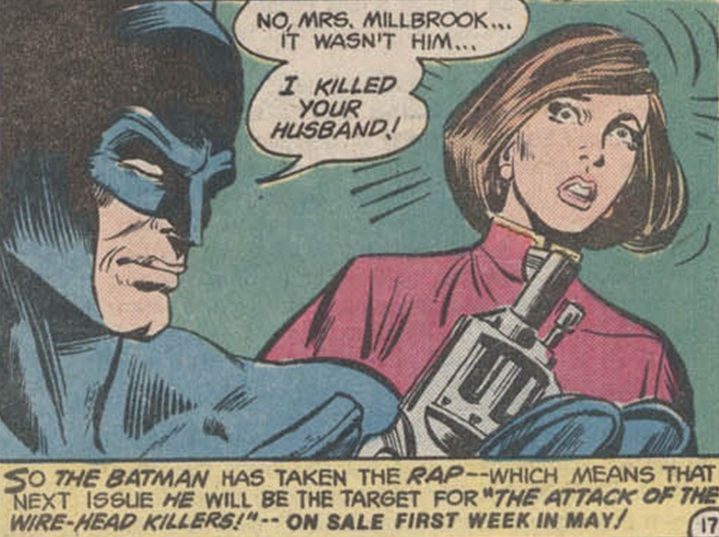
Some of the darker comic book interpretations of Batman have intentionally cultivated lethal reputations in order to intimidate their criminal foes, despite having never actually killed anyone. The Post-Crisis Batman tricks Superman into thinking he’s prepared to kill an innocent person when they first meet in John Byrne’s Superman: The Man of Steel (1986). In Alan Grant and Norm Breyfogle’s Batman: The Last Arkham (1992), Batman and Gordon conspire to make it looks as if the Dark Knight murdered a police officer named Lieutenant Kitch. In Batman: KnightsEnd (1994), Bruce makes Lady Shiva think he’s murdered one of the disciples of Armless Master. There have also been countless comic stories in which either Bruce or Batman is framed for murder by an enemy. But in all of these stories, as in the Nolanverse, the truth of Batman’s innocence is eventually revealed.
Batman’s line about him being whatever Gotham needs him to be could be a metafictional allusion to the widely varying interpretations the character has been subjected to over the decades. He’s been portrayed as everything from a deputised agent of the law who carefully observes traffic laws (the 1966-1968 TV show), to a dangerous vigilante who has no problem with the public believing he murdered the Joker (The Dark Knight Returns).
The scene where Gordon smashes the Bat-Signal with an axe recalls a scene from ‘Commissioner Gordon Walks a Beat’ (Detective Comics Vol 1 #121, March 1947) in which Gordon’s successor, Commissioner Vane, does the exact same thing.

Gordon himself smashes the Bat-Signal in ‘Commissioner Gordon: The Long Dark Night’ (Batman: Shadow of the Bat Vol 1 #28, June 1994). In the comic Gordon does this out of disgust at the Jean-Paul Valley Batman killing Abattoir. In the movie he does it in mock outrage over Batman killing Two-Face.
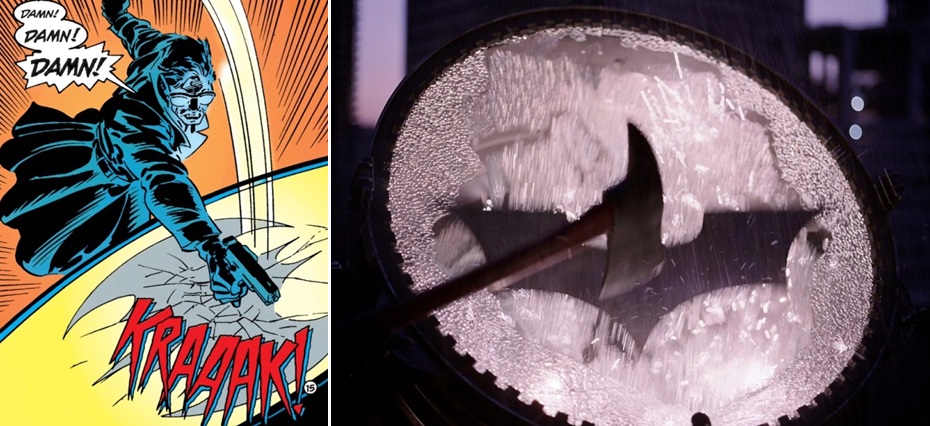
The film ends with Batman being hunted by the police. The image of him running from the police dogs might have been inspired by a similar scene from Batman: Year 100.
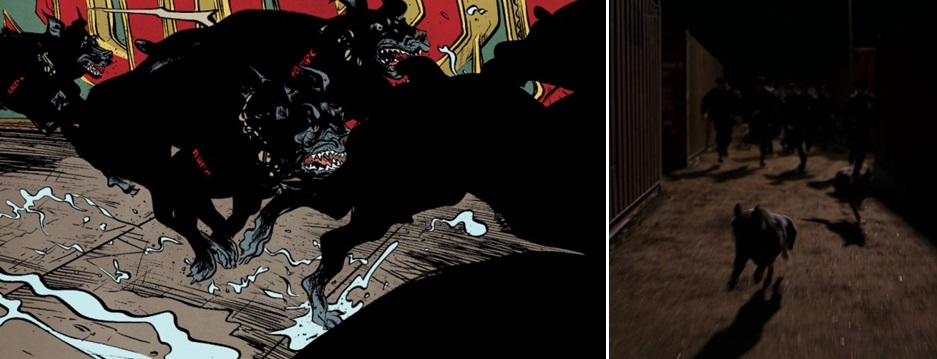
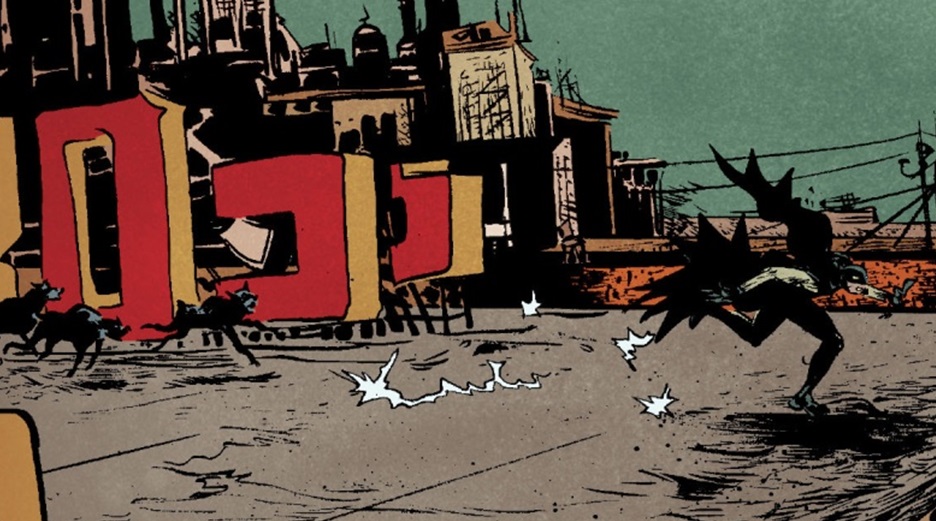
And that concludes this analysis of The Dark Knight.
comments powered by Disqus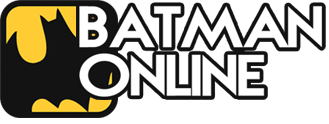

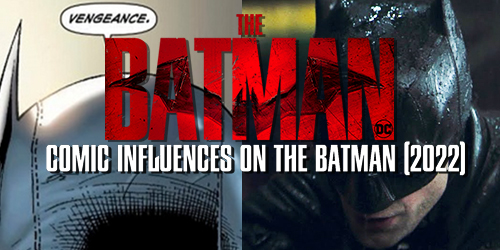
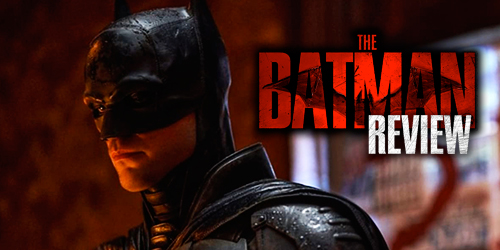

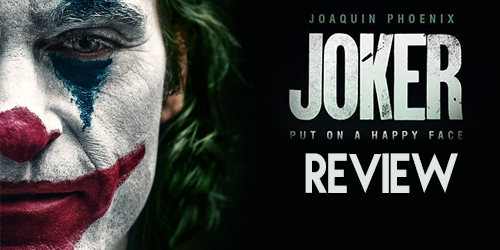
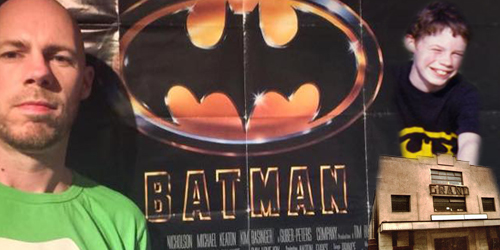


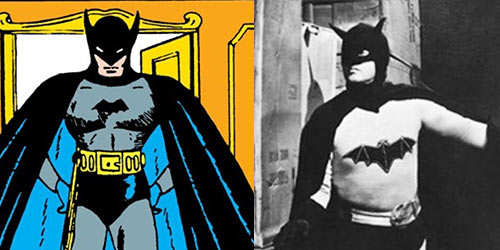

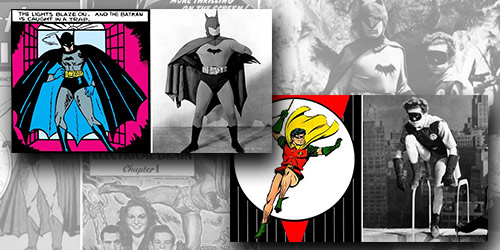


by Kamdan
by thecolorsblend
by The Laughing Fish
by The Laughing Fish
by The Laughing Fish
by The Laughing Fish
by The Laughing Fish
by The Laughing Fish
by The Dark Knight
by The Joker